-
Posts
2925 -
Joined
-
Days Won
25
Content Type
Profiles
Forums
Events
Posts posted by Rad
-
-
I'm growing out my hair and shopping for a red Prana top

Jacinda Hunter - Balancing climbing and family
-
Thanks. It was our first time up there. We were lucky to have good weather for our summit day. Our original goal was to do a high ridge line traverse, but delays in the early part of our trip made that impossible. So did we succeed or did we fail?
On the last day of our trip, we encountered novice hikers and experienced climbers who asked if we successfully made it to the summit. They offered congratulations when we told them we did. This felt wierd, because our summit day was technically, mentally, and physically less challenging than many other parts of our trip. The greatest rewards lay in overcoming the various challenges we encountered along the way, spending time with a close friend, and experiencing nature on its own terms.
I've found the Pickets trips force me to let go of the future, let go of the past, and fully experience the reality of the here and now. One step at a time.
-
Impressive!
This is one of those routes that looks inspiring from the parking lot, Boston Basin, and other spots in the area, but accounts and pictures of the lower half make it look just plain nasty. No wonder Ivan loves it so much.
-
Anyone know if this closure is likely to be lifted before the 31st or who I can contact to find out updates?
Thx
Rad
-
I'm not worried about this area ever being swarmed by hordes of climbers/hikers, but yes, camping on snow or rock is better than squashing the heather.
I watched reports on this route over several years and noticed that many parties that went later in the season got turned back by an impassable, or at least very difficult, bergschrund on the Challenger Glacier. So we intentionally went when snow levels would be high. An added advantage is that the traverse below Whatcom was a piece of cake. I've heard that when this melts out it reveals dirty, exposed, downsloping slabs that are unpleasant at best. We really enjoyed doing a loop so we could see as much new terrain as possible.
-
The paleo diet is based on the idea that humans have not evolved quickly enough to eat a modern diet, and that therefore we should eat like neolithic hunter-gatherers of 50,000 years ago as that is what our bodies have evolved to consume.
Entirely incorrect. Genetic studies have proven that genes involved with diet have been highly selected for over only the last few thousand years - lactose tolerance has evolved three separate times by three different genetic pathways within the last 6,000 years, for instance.
Studies of the human microbiome now underway are demonstrating how little of the human genome, and how much of our commensal passengers (who evolve much faster than us) are involved in digestion.
In short the scientific hypothesis behind the paleo diet has been completely falsified. Hence my comparison to homeopathy.
thanks for interesting post. what, 3 to 6 lbs of the critters in the average human gut, and we are born without any.
and speaking of homeopathics, what do you, as a scientist, think about the placebo effect?
As another scientist, I can say that the placebo affect is very real. That's why gold standard human experiments are double blind (neither researcher nor subject know who gets the treatment and who gets the control until after the results are all in).
Gspotter speaks the truth: gut microbes play a huge role in many factors, from obesity, nutrition, and autoimmune disorders and even GI cancers. And yes, we go from empty vessels to colonzed with billions of microbes in a fairly short time. There was a recent set of articles in Science that delved into these in some detail. A few takeways:
We have complex, dynamic ecosystems of microbes living in all of us. These communities affect many aspects of our health.
We're all born with no microbes in gut. First ones come from passage through the birth canal. C section kids have different gut flora for a while. These start to be replaced (think succession in a forest) with the introduction of solid food) and are largely supplanted by age 3. After that, microbe populations are tremendously affected by diet, stress and other host factors, medications (particularly the use of antibiotics), and other factors.
People who are exposed to less dirt and viruses and bacteria as kids tend to develop more allergies and even serious immune disorders later in life.
Thinking of bacteria as "bad" and "invaders" is wrong-headed. We CO-EVOLVED with them, though they evolve much faster than us. We depend on them. They depend on us. We will never be rid of them, nor should we want to be. We should think of ourselves as stewards of this ecosystem.
-
Sweet Blake! Look forward to climbing this and the other new routes you'll be adding to our beloved PNW.
-
July is the new June. Expect tons of snow up there this year. Enjoy!
-
A grand day out and some great lighting. That one with prints and the rope marks is stunning.
Steph, great to see you back in the mountains!
-
Trip: Challenger via Easy Ridge and Perfect Pass, return via Whatcom Pass
Date: 7/26/2011
Trip Report:
Ed and I have had some great adventures together, including one on Inspiration in the southern Pickets.
Last year we headed in to Challenger in the northern Pickets. To make a long story short, Easy Ridge wasn't easy and Challenger wasn't challenging. The amount of snow we encountered at the end of July was impressive. I was REALLY glad I didn't wear my Guide Tennies on the "approach" to Challenger. Sportiva Makalus were dope in the snow. Did I mention there was tons of snow? You'll see... This year I suspect the snowpack will be similar.
Any trip in the Pickets is likely to be a grand adventure. You're guaranteed to get tested in unexpected ways. We sure were.
DAY 1
Obligatory clean shot upon departure.
Skies were bright. We were leaving civilization for the wildest mountains in the lower 48. Life was good.
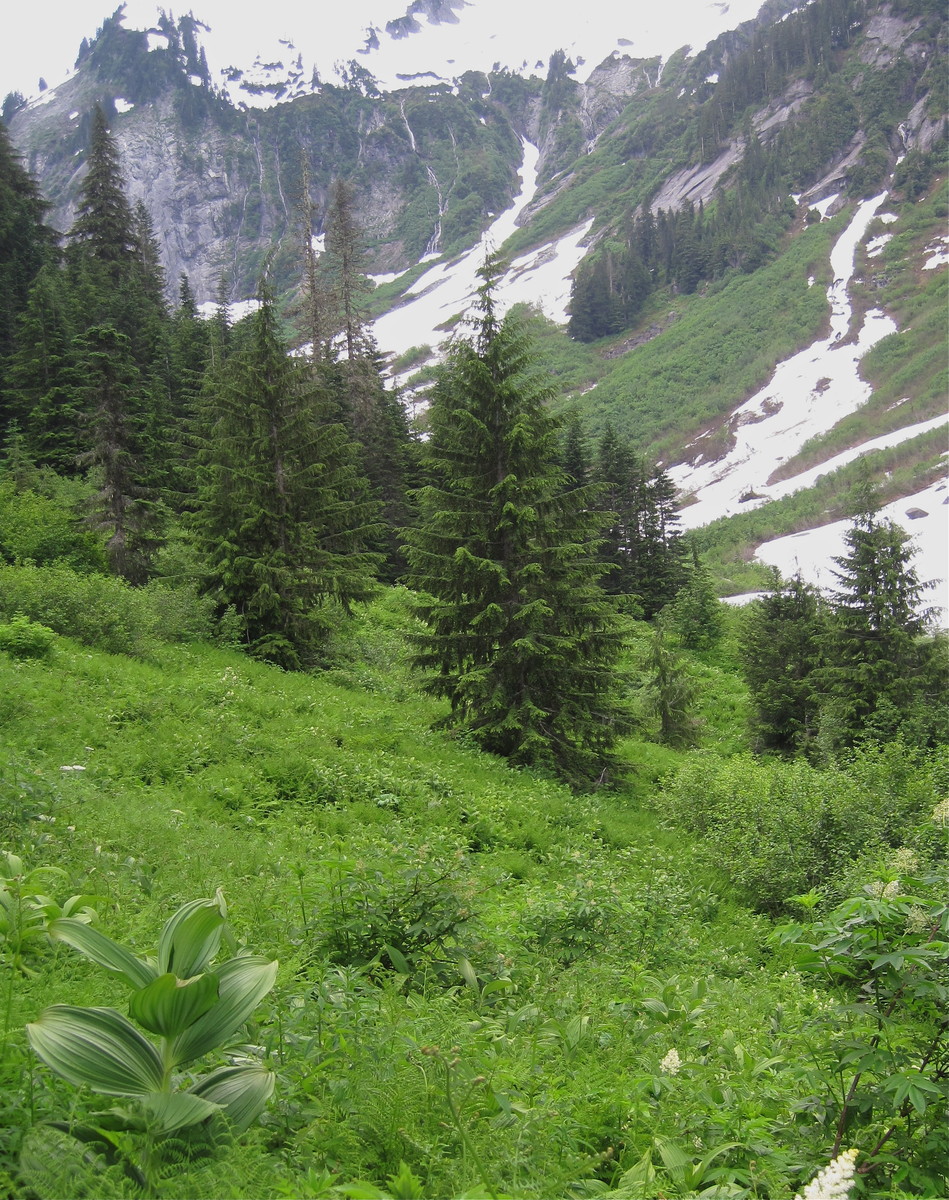
We passed several creeks with progressively thinner snow bridges.

Then we came to one where the "snow" bridge consisted of rock hard ice that looked to be less than an inch thick at its midpoint.
Lurking underneath was a 12-14ft drop to a tumbling stream of icy meltwater.
The lip would be extremely undercut if you broke through. It was unclear if/how you would ever get out.
The safest solution seemed to be to go up and around: stem between hard mud and ice.
When you start accelerating down the mud faster than you can control you jump for a small, wet, downsloping ledge next to the waterfall.
Make sure you stick the landing or you're going over the waterfall.
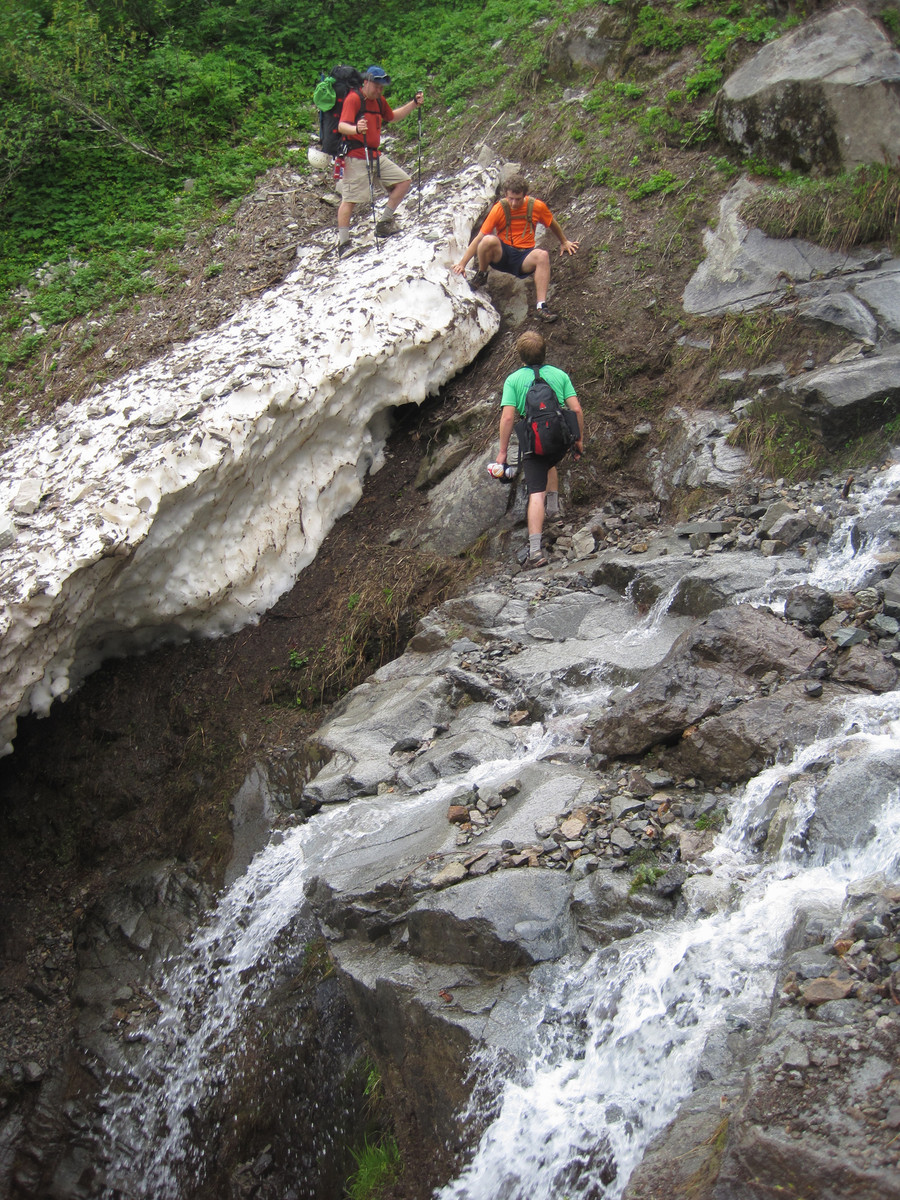
The forecast had called for bluebird skies for a week, but at Hannegan Pass the misty rain started. It wouldn't stop for three days.

Navigation in the mists would provide several days of entertainment for us.
We were able to make it off the upper plateau and find the trail in the forest.
We followed this down below the snow line, eventually reaching the turn-off for the Chiliwack crossing.
It wasn't bad.
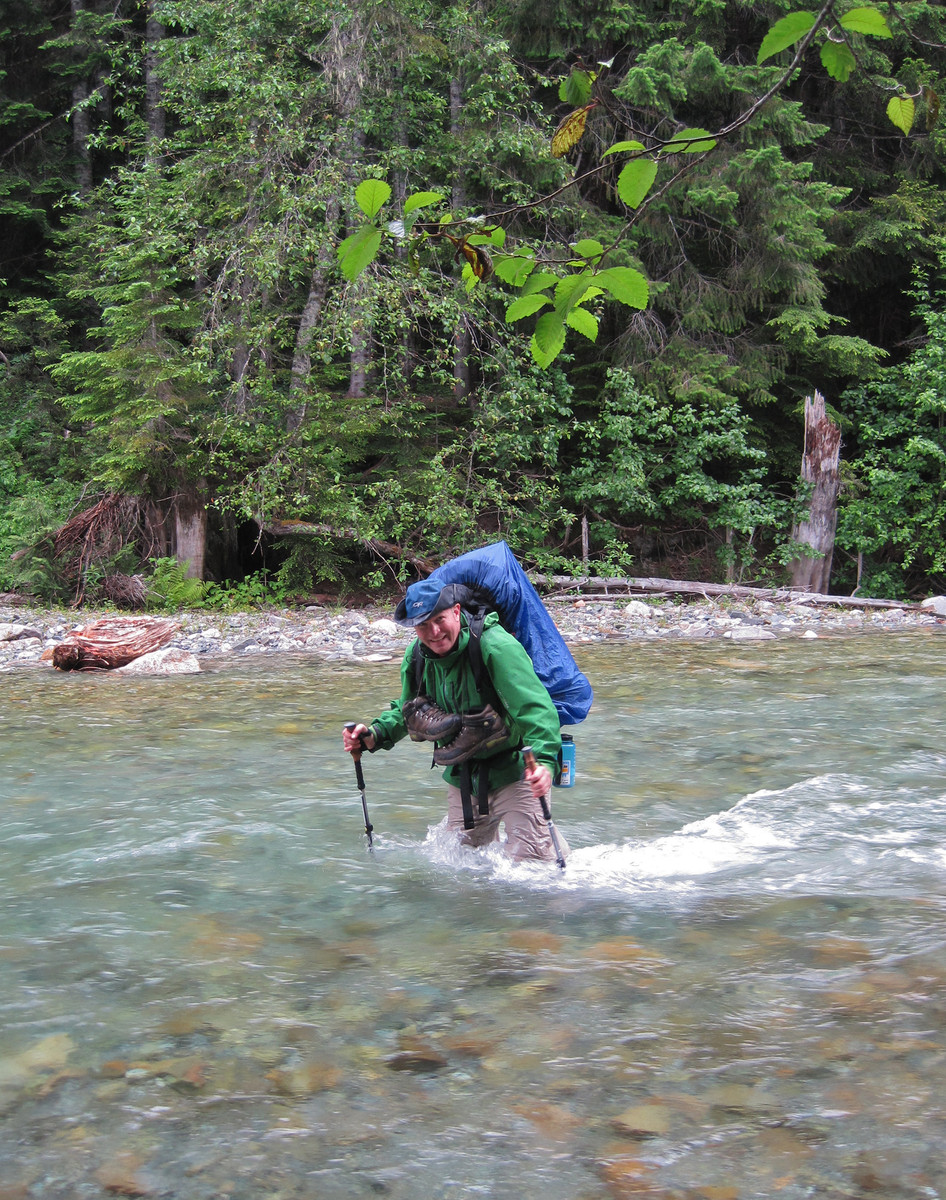
On the far side, I stashed my running shoes and some food.
We spent a few minutes finding the overgrown trail up to Easy Ridge and followed it off into the forest.
This trail was a timeless purgatory.
It featured endless switchbacks through silent, dripping forest that always looked the same.
You'd gain about 50 vertical feet in a half mile long switchback. Repeat X 50, or so it seemed.
There were no views, no landmarks, no water sources, no decent camping spots, and no way of knowing how far you had to go.
Between rain and dripping bushes, we got thoroughly wet, but there wasn't a drop of water to drink.
Eventually we found a miserable sloping spot next to a snow patch, pitched our tent in the pine needles, ate dinner, melted dirty snow to re-hydrate, and crashed hard.
We slept in late and then started up the hill.
DAY 2
In a few switchbacks we were onto snow and following fresh bear tracks toward what we guessed was Easy Ridge.
Even though this route must get some traffic, we wouldn't see any signs of other humans (trail, footsteps, cairns, or anything else) for several days.
Mountains peeked out from their misty veils and then disappeared again.
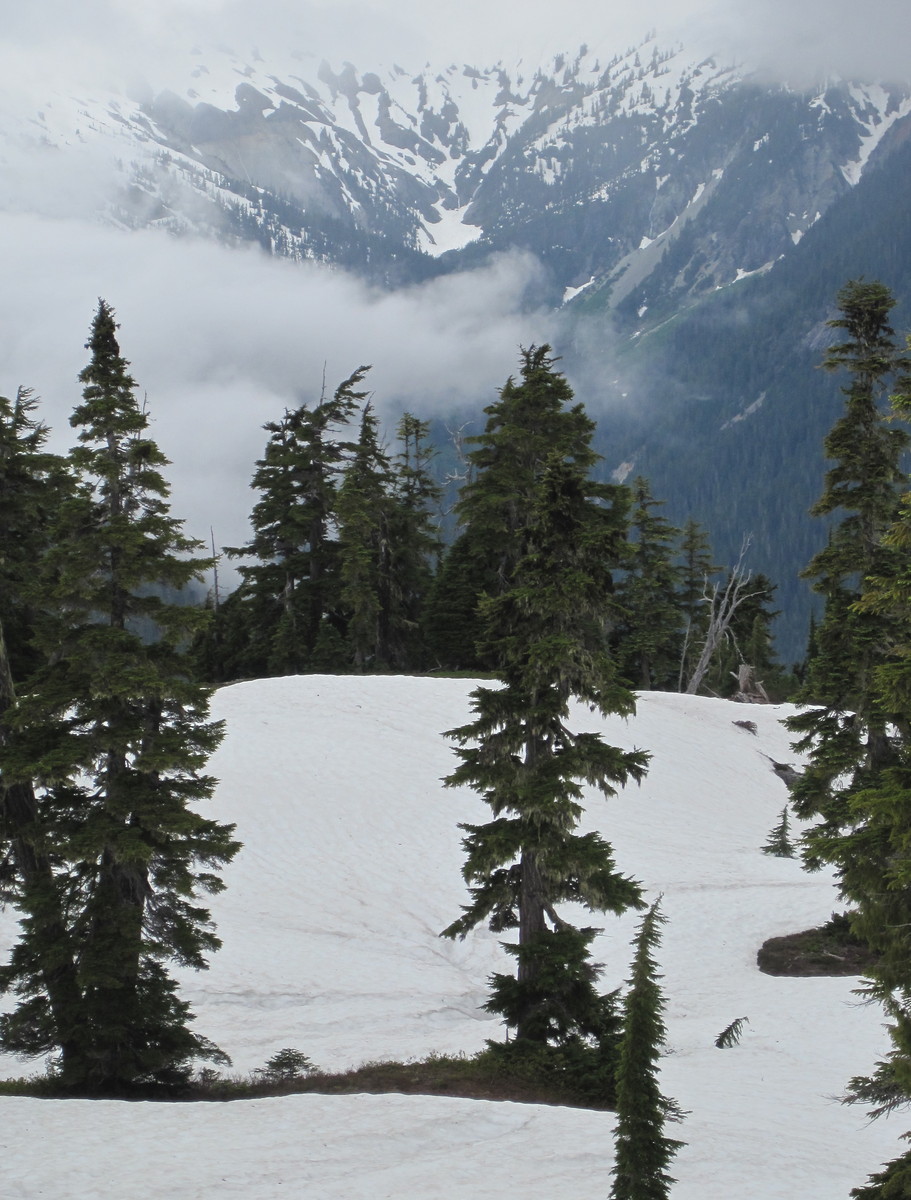
We ascended back up into the mists along Easy Ridge and encountered our first major obstacle:
A steep snow slope that seemed to end in a cornice above us and dropped out of sight in the mists below us.
It was easy to jam an ax in the soft snow, but slope angle and heavy pack meant it would be nearly impossible to self arrest in the event of a fall.
It was slow going.
Eventually, we came to a set of rotten rock and rubble before a final snow step.
As I wallowed up on the edge of the snow and some broken rock, I dislodged a large block that slid back toward Ed.
We looked at each other.
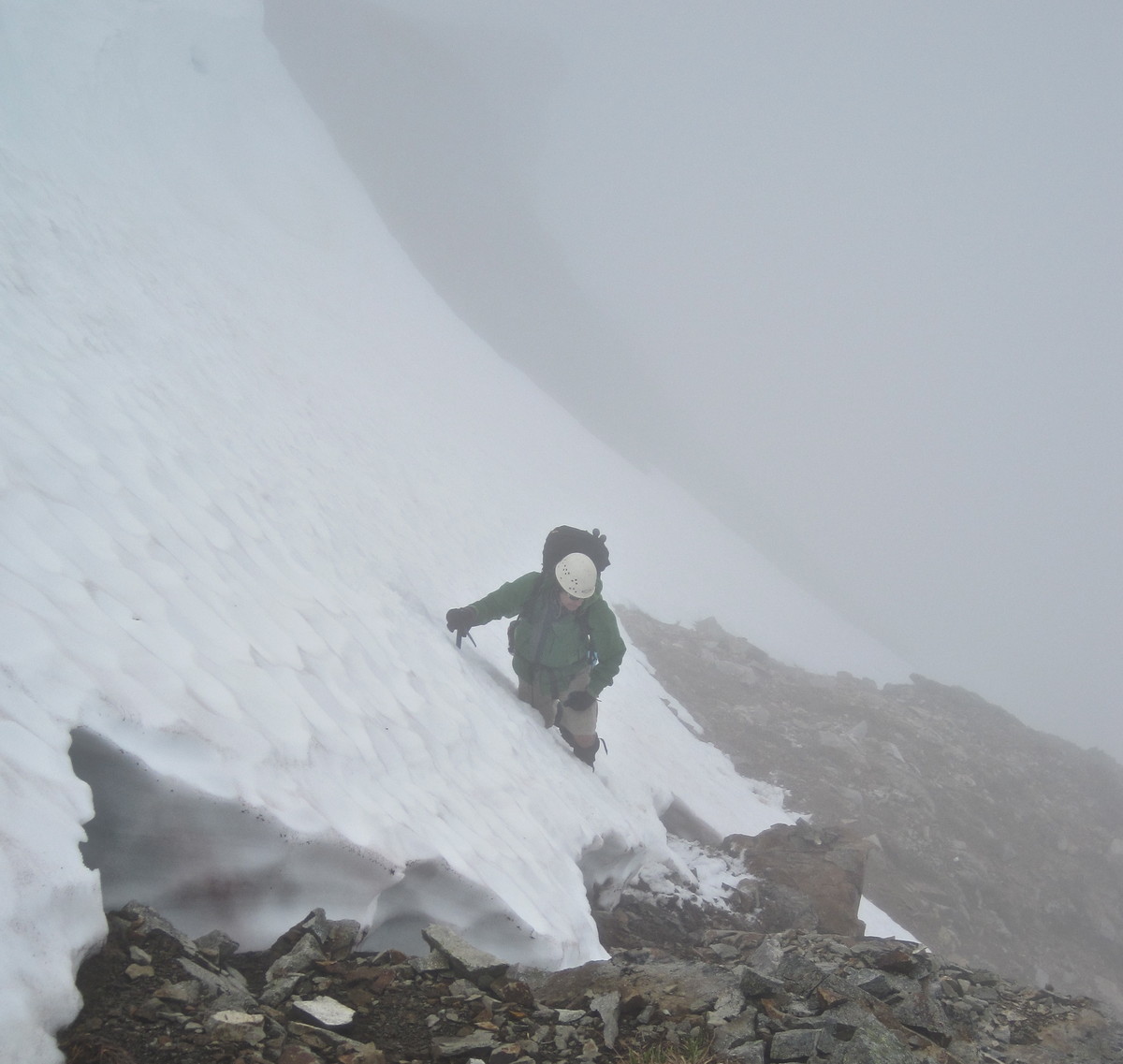
"Rad, how much do you want this?"
"I don't know, but I'm not ready to turn around just yet."
I suspected the ridge might flatten out above this step, at least that's what the topo suggested.
We couldn't see more than 50 feet due to fog/cloud.
The lip above us might lead to a flat ridgetop or it might be the edge of an undercut cornice.
Fortunately, it was a transition to easy ground.
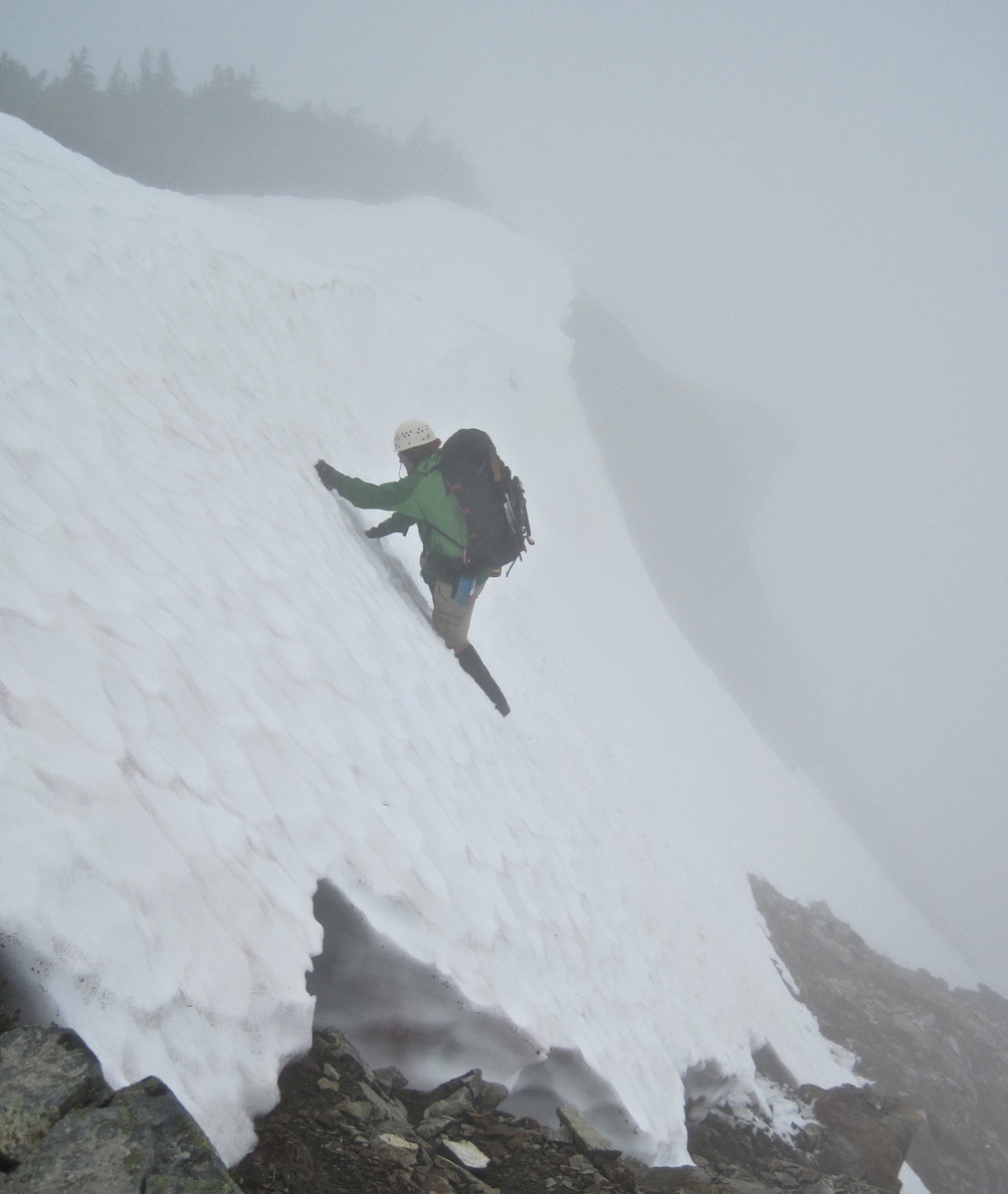
Several people have told me this red algae tastes like watermelon. Not so much.
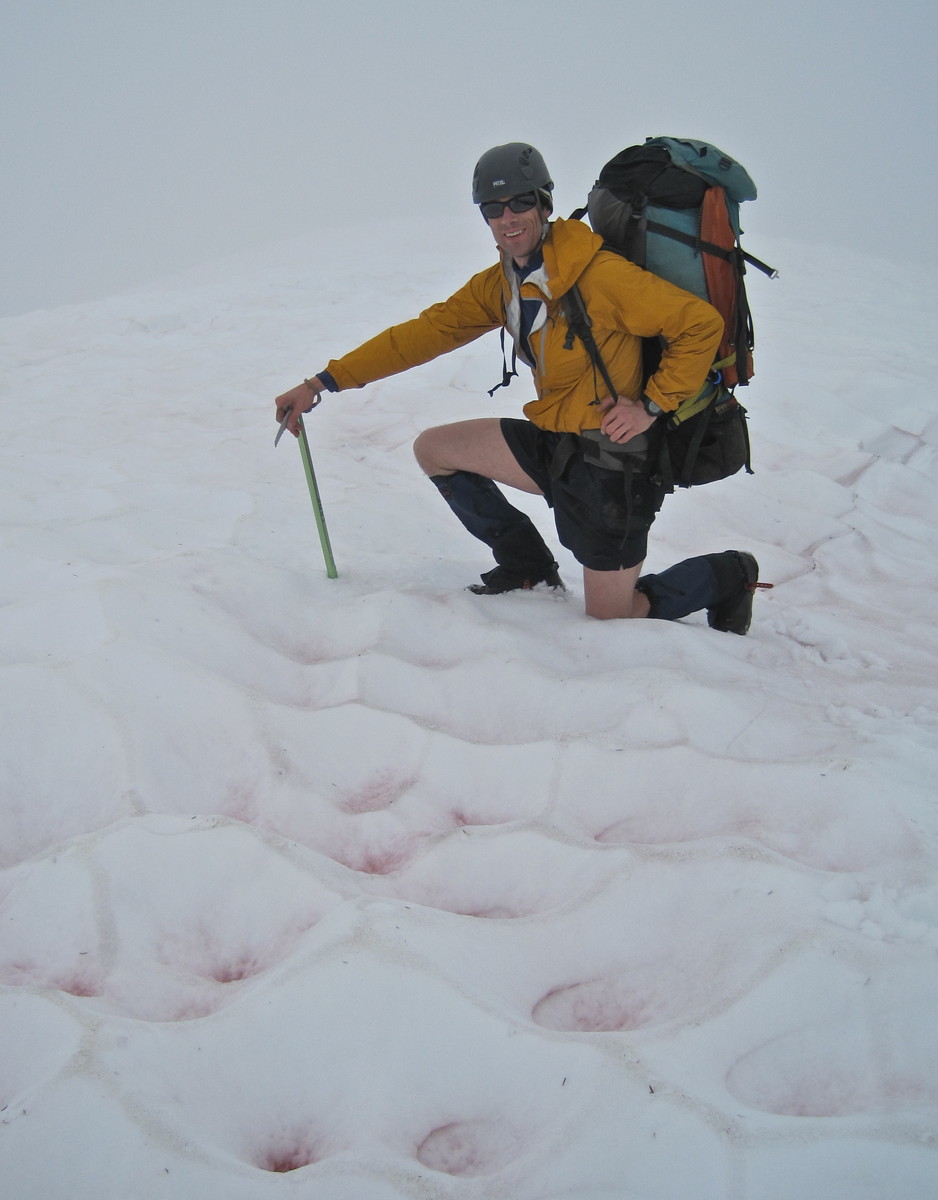
We followed the ridge for a way, being careful to stay away from the misty horizon where snow blended in with the fog.
We wouldn't fully appreciate how undercut these cornices were until we saw them from the valley below several days later.
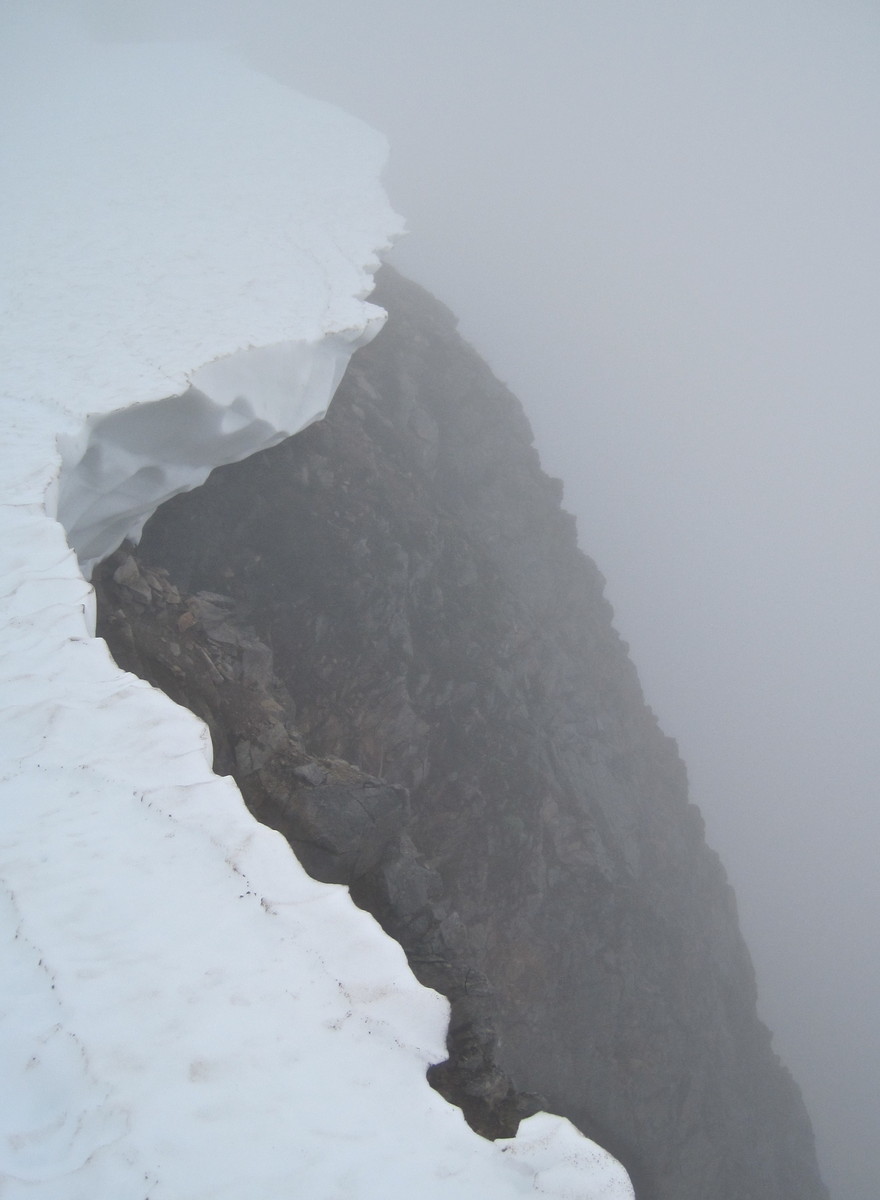
Near the summit of Easy Peak we found a comfortable spot to camp and called it good, knowing we'd never make it to Perfect Pass before dark.
It was my anniversary, so I called my wife on the sat phone and said goodnight to our kids.
Of course it had been sunny and warm in Seattle.
I turned off the phone and returned to our world of mountain mists.

DAY 3
In the morning we found a way off Easy Peak and traversed toward the Imperfect Impasse, a deep chasm that runs from high on the ridge down to the valley floor.
It's hidden between the snow and waterfall in this photo.
The chasm is visible in the lower left.
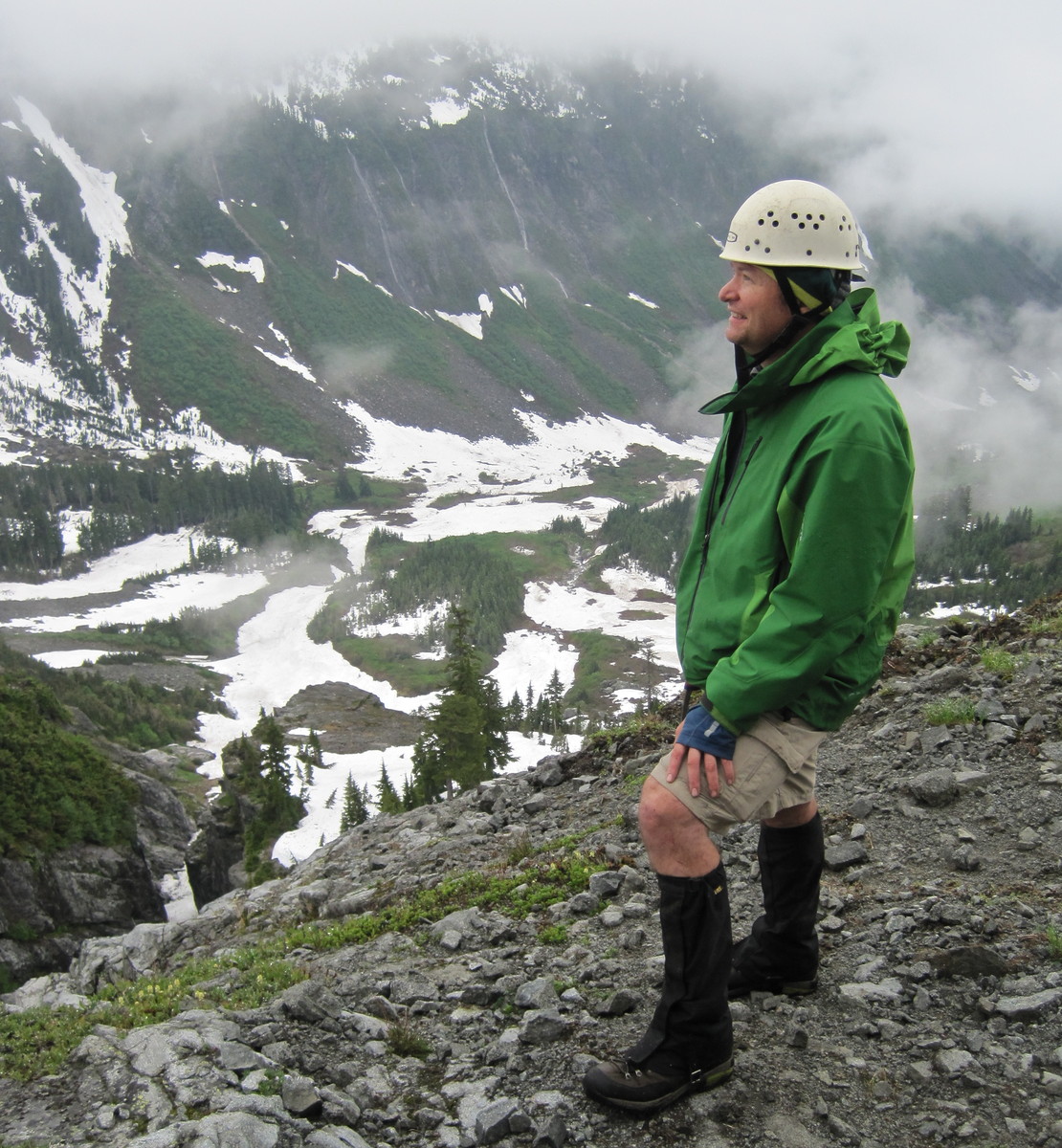
We tried the high route first, in hopes that it would save us a few thousand feet of elevation gain and loss.
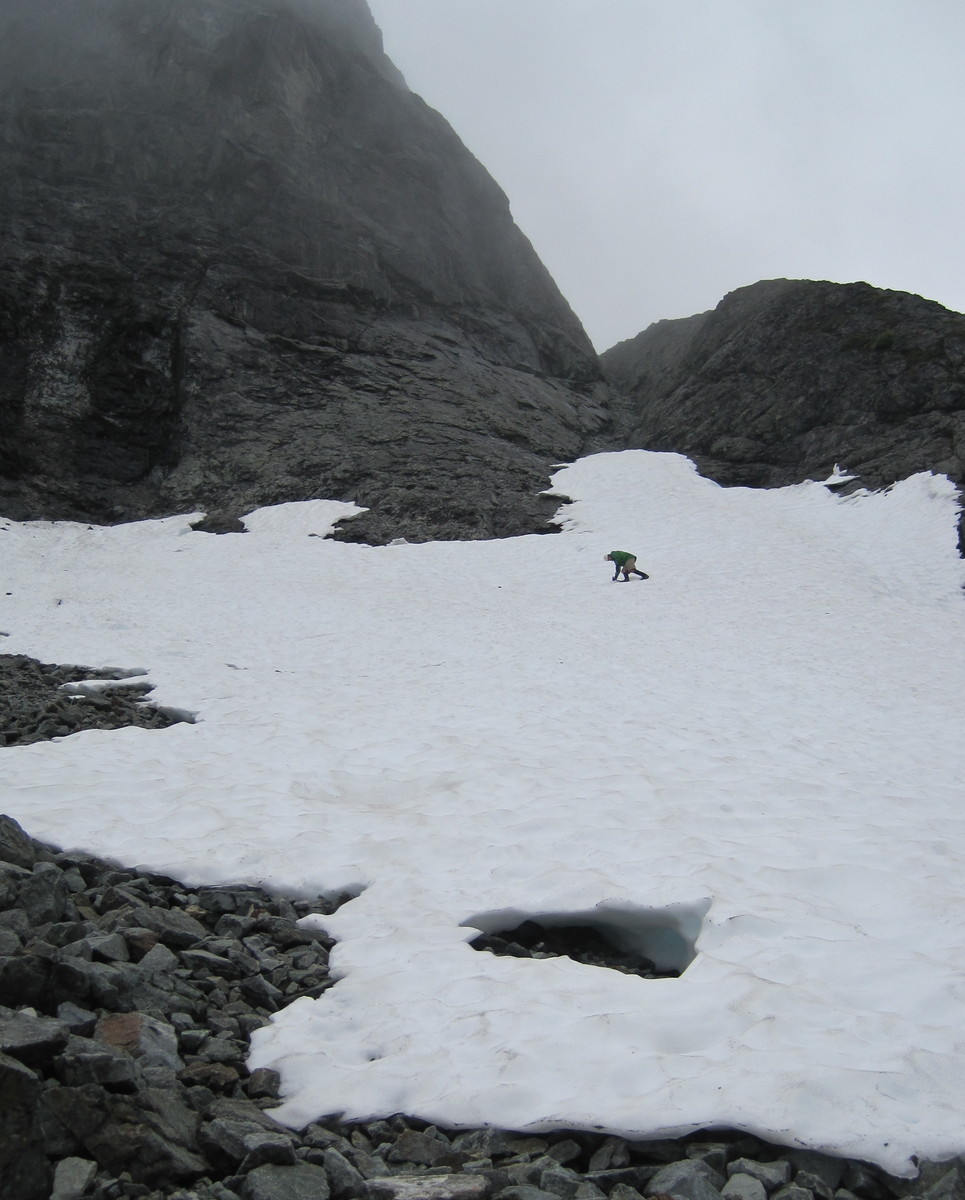
The snow was harder than expected, and the rock was wetter than expected.
The snow in this shot should be around 35 degrees.
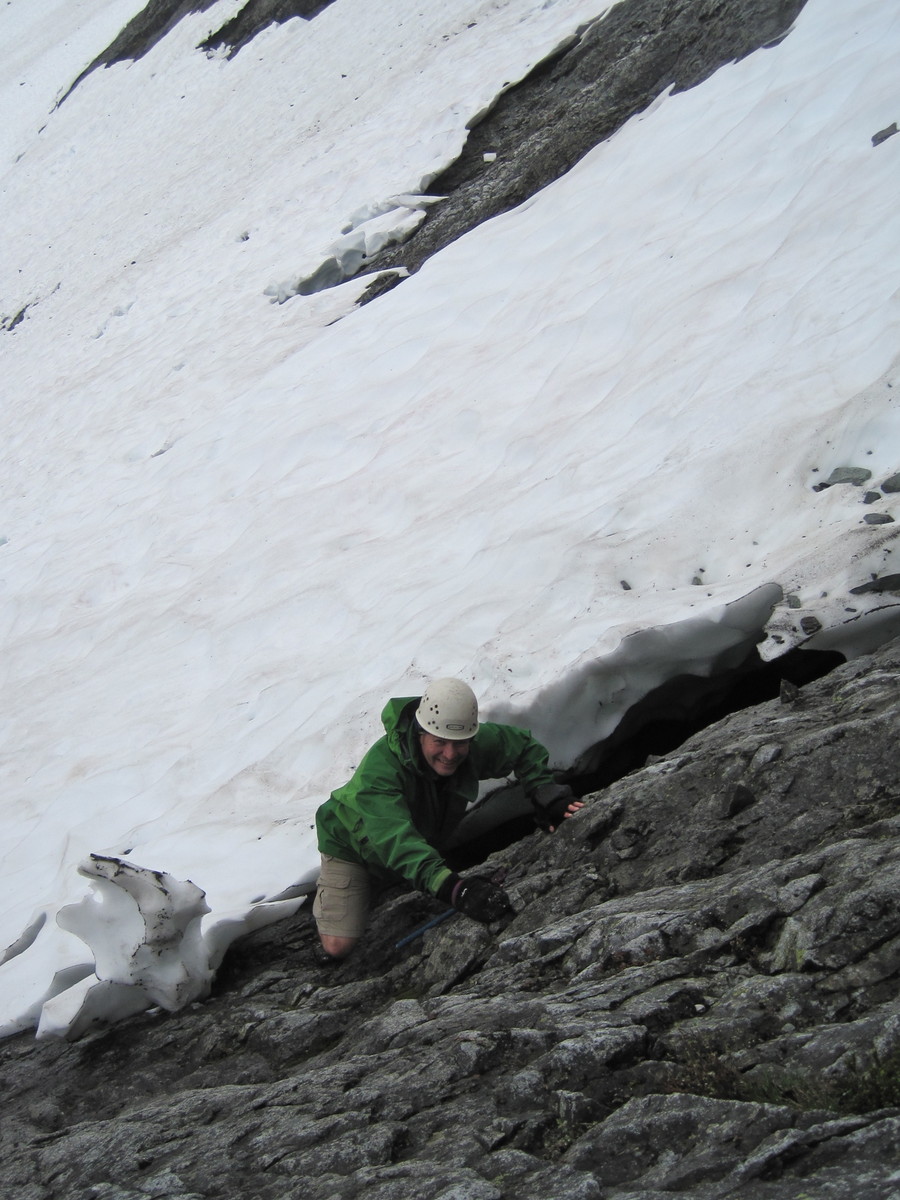
We did gain the rock and scramble to the edge of the Impasse chasm, but we didn't see a reasonable way past it.
So we climbed back down the snow, boot skied to the valley floor, crossed a few creeks, and looked for passage up to Perfect Pass.
The sounds of falling water, gentle winds, and icefalls filled the air.
It was a stunning and wild place to be, with no sign of human passage and no indication of which way to go.
This hanging glacier sent showers of ice blocks onto the valley floor.
We pieced together a line up heather and a small patch of steep forest that avoided the soaking slabs.
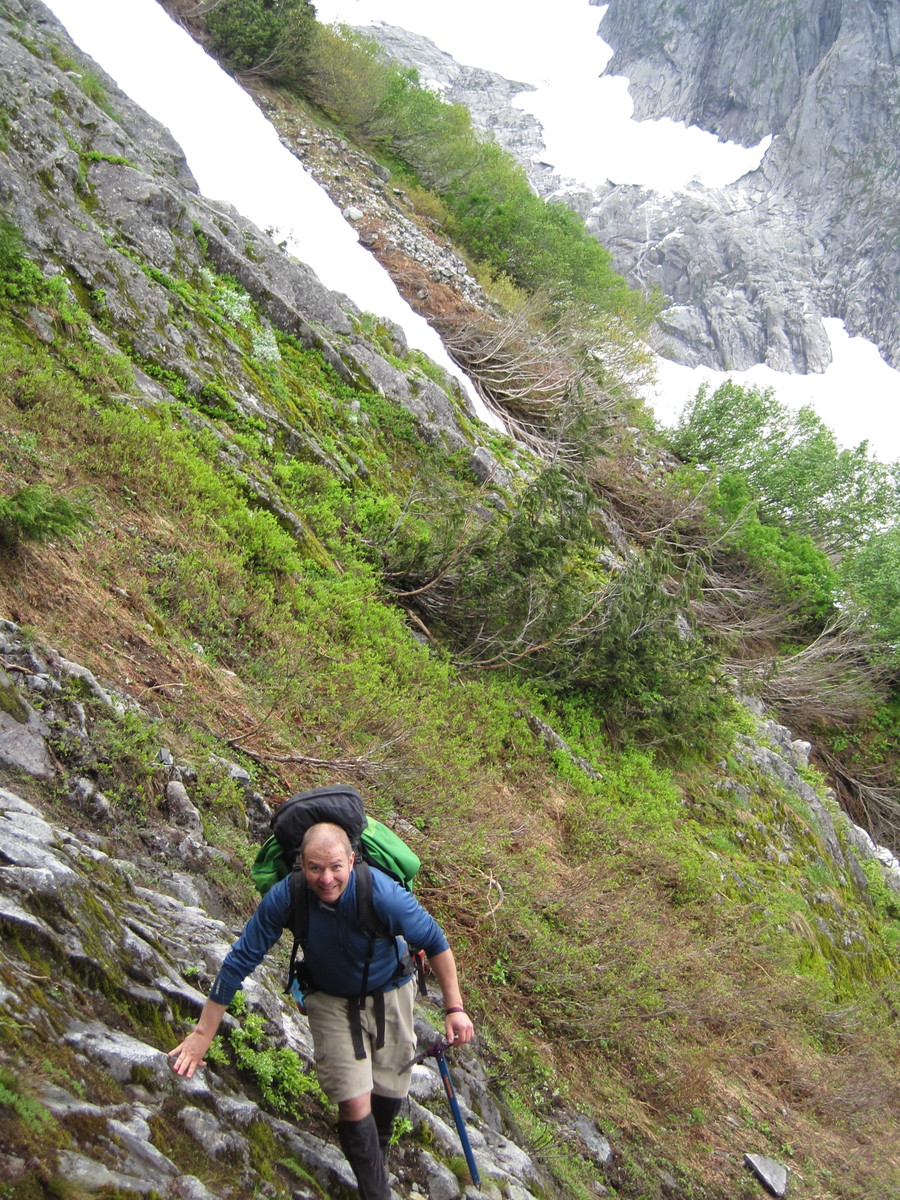
Then we crossed over to the upper snow fields. Every step was insecure and required focus.

It's good to be reminded how small and insignificant we are.
Bizarre ice blocks dotted the upper snowfield.
We took a few silly photos,
A couple of minutes later a shower of large blocks started cascading down toward us.
We sprinted sideways to escape. The blocks came to rest next to the ones we'd passed.
Apparently, the blocks had fallen off the giant arch above us. Riddle solved...and survived.
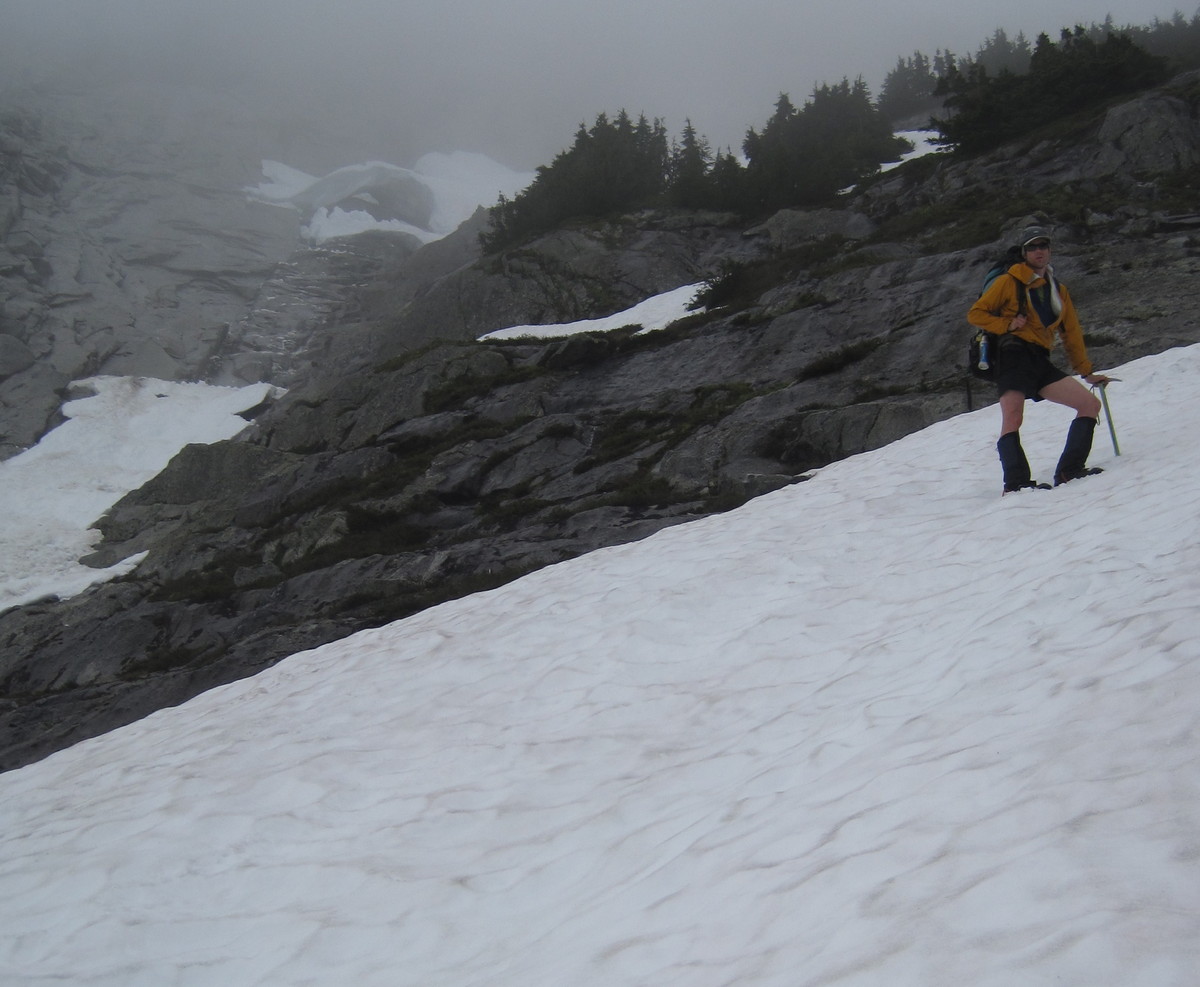
The cloud ceiling lifted a bit to reveal our path from Easy Peak.
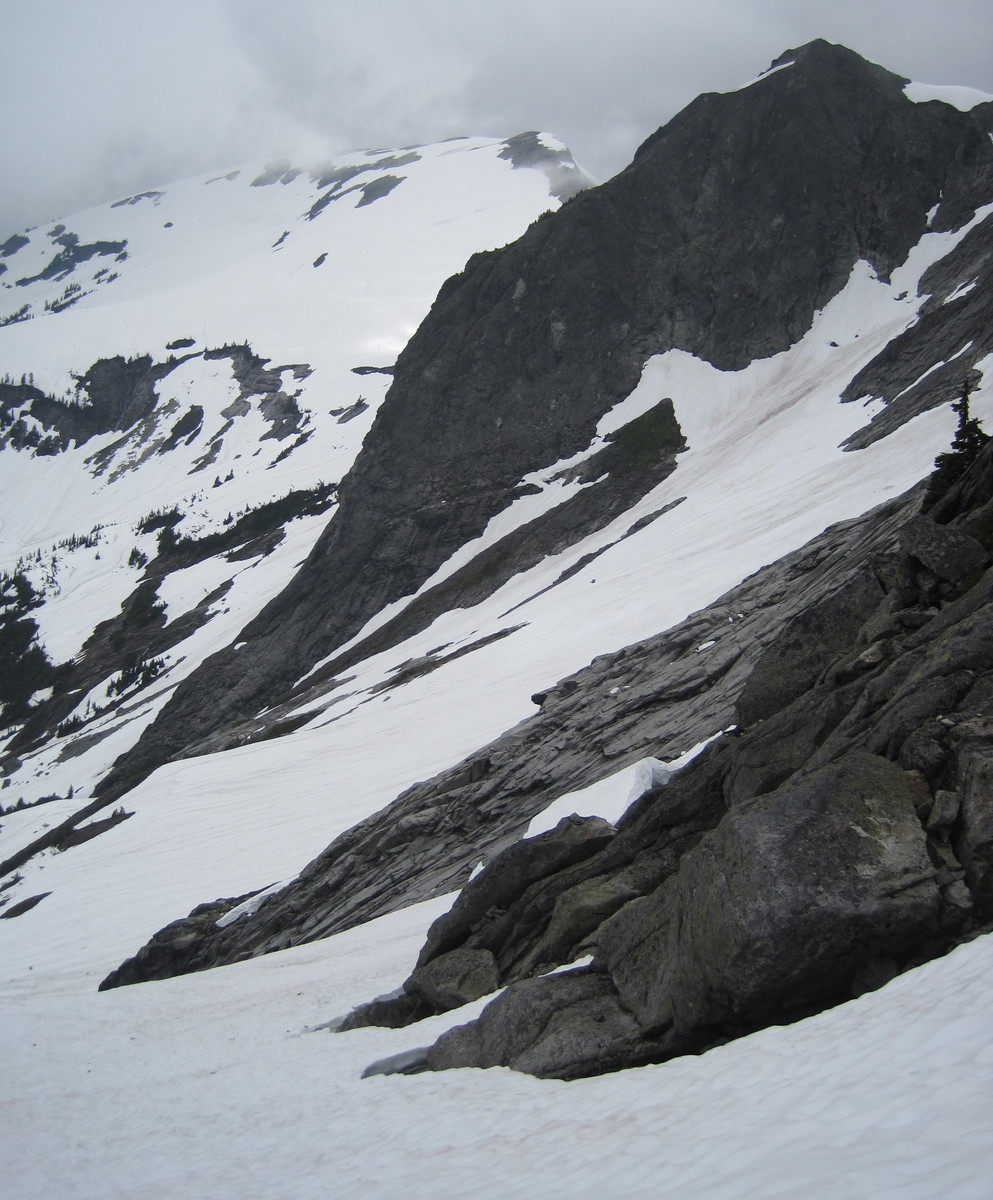
We followed safer snow up, and Perfect Pass seemed just ahead.
But first we had to climb up waterfalls and mossy slabs.
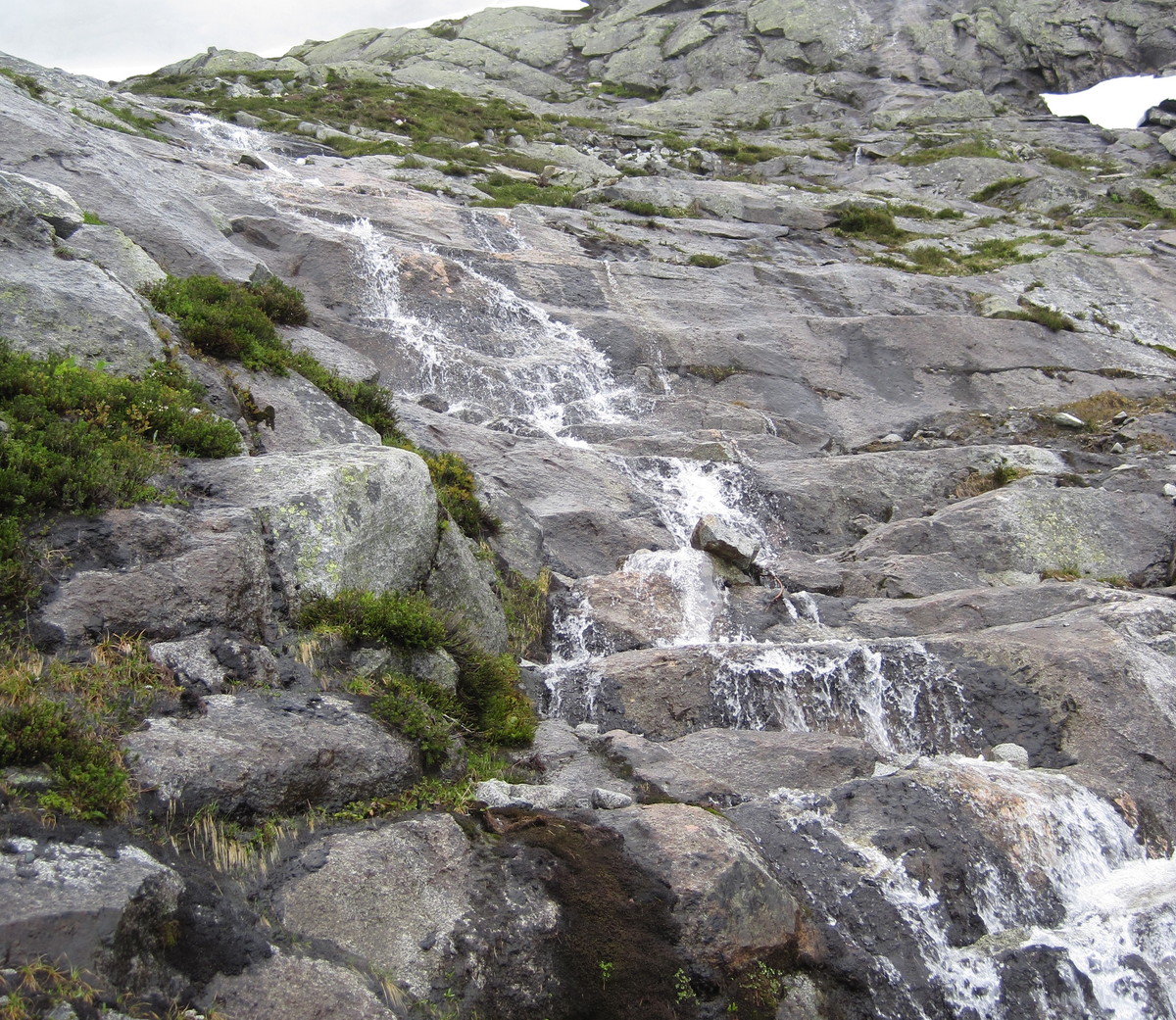
At last, we made it to Perfect Pass. There was 20ft of snow in places.
A party of two, the first people we'd seen since since Hannegan Pass, departed for the Challenger Arm.
Getting to Perfect Pass seemed like a major accomplishment.
At many points over the previous two days we'd doubted if we'd be able to make it here.
There had been no trail, no footsteps, and no sign of human passage since we hit snow line by the bear tracks.
And this was just the "approach". Welcome to Pickets!
Clouds formed around us at Perfect Pass, but we hoped lighter skies to the West might bring good weather and give us a chance to summit Challenger the next day.
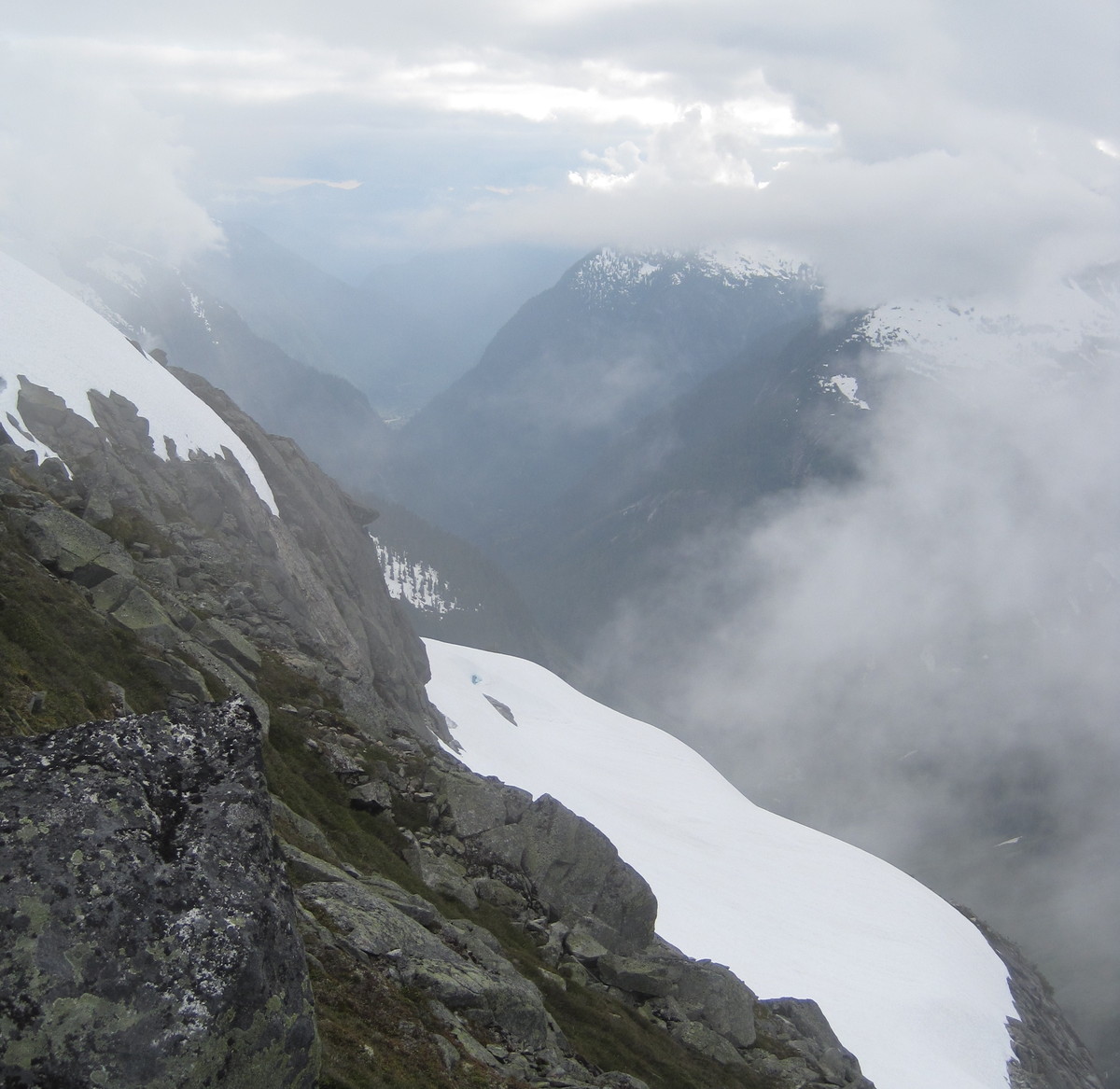
DAY 4
The weather gods smiled on us with clear skies.
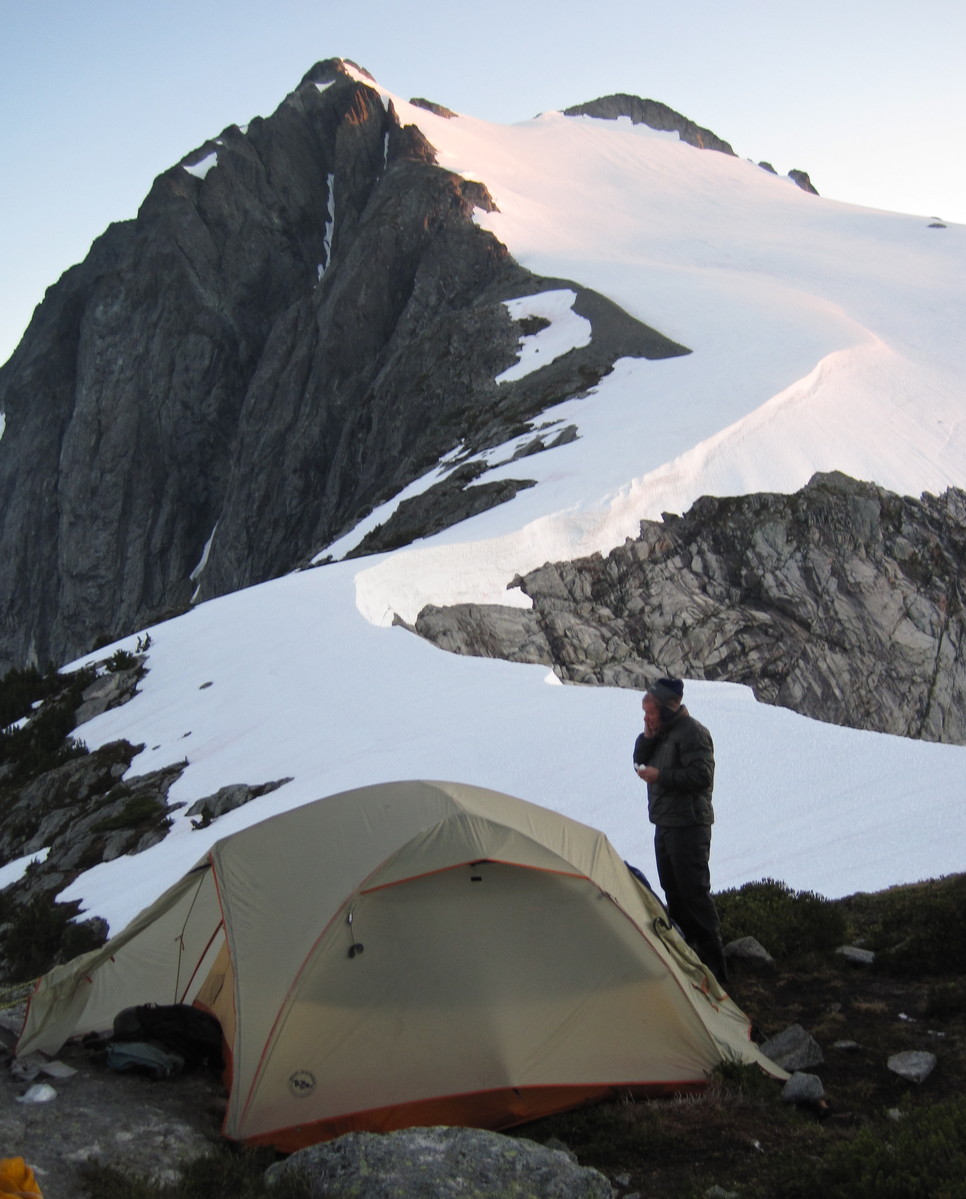
Baker, Shuksan, and everything in between was out.
Unfortunately, Ed felt like crap.
The Challenger summit is just right of the distant notch below.
We started across the massive Challenger Glacier, uncertain if Ed would feel better or worse.
The glacier was almost completely filled in, making travel quick and easy.
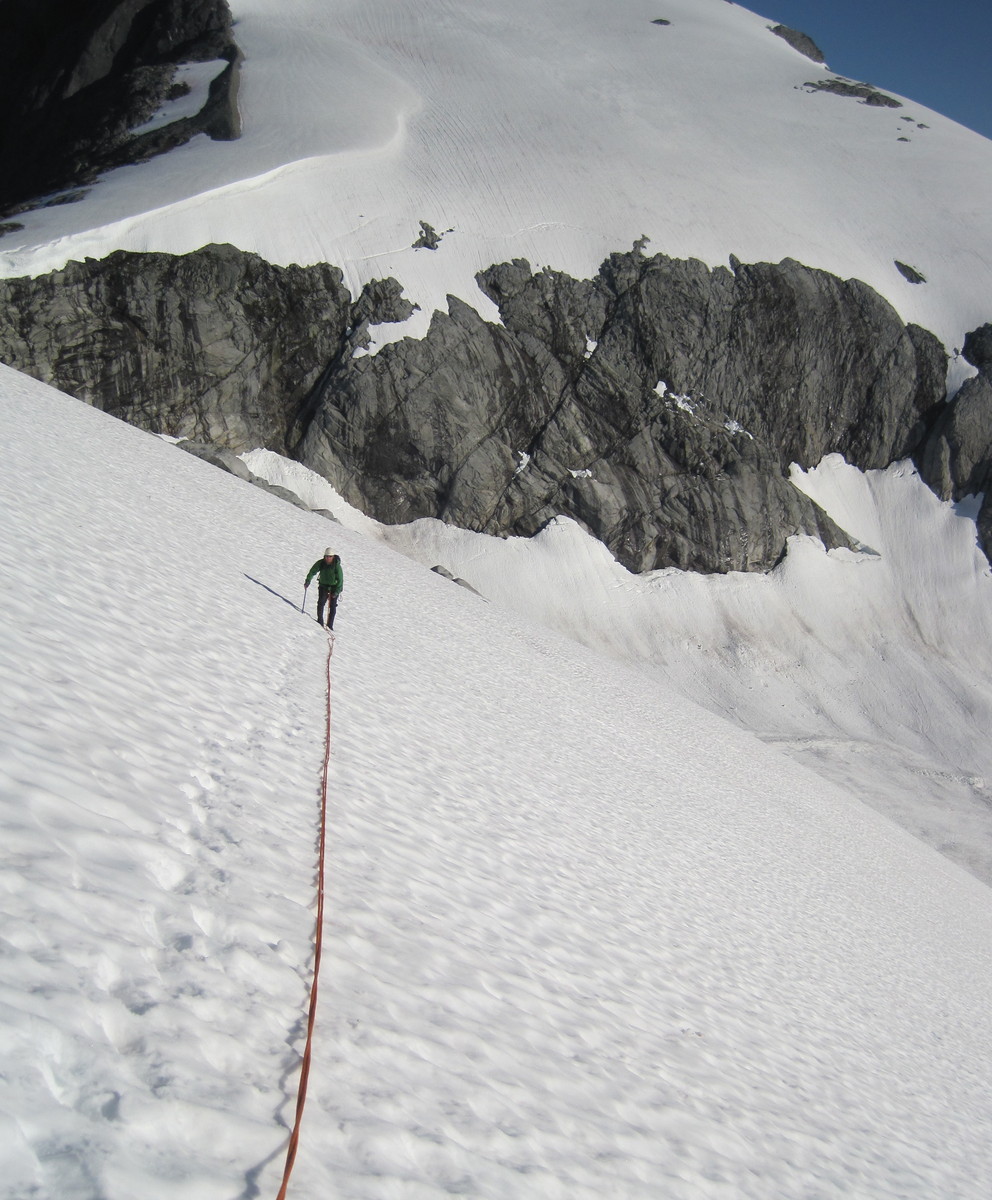
This shot shows the traverse across Whatcom we'd use on the way out.
Perfect Pass from Challenger Arm.
Heading up toward the massive bergschrund.
Ed was still feeling crappy, occasionally doubling over in mysterious abdominal pain.
He knew I'd turn around if needed and not be angry with him.
I knew he wouldn't turn around unless he had to.
Nothing more needed to be said.
Upper snow slopes before the final rock section.
Headed for the summit.
One of Challengers lesser peaks
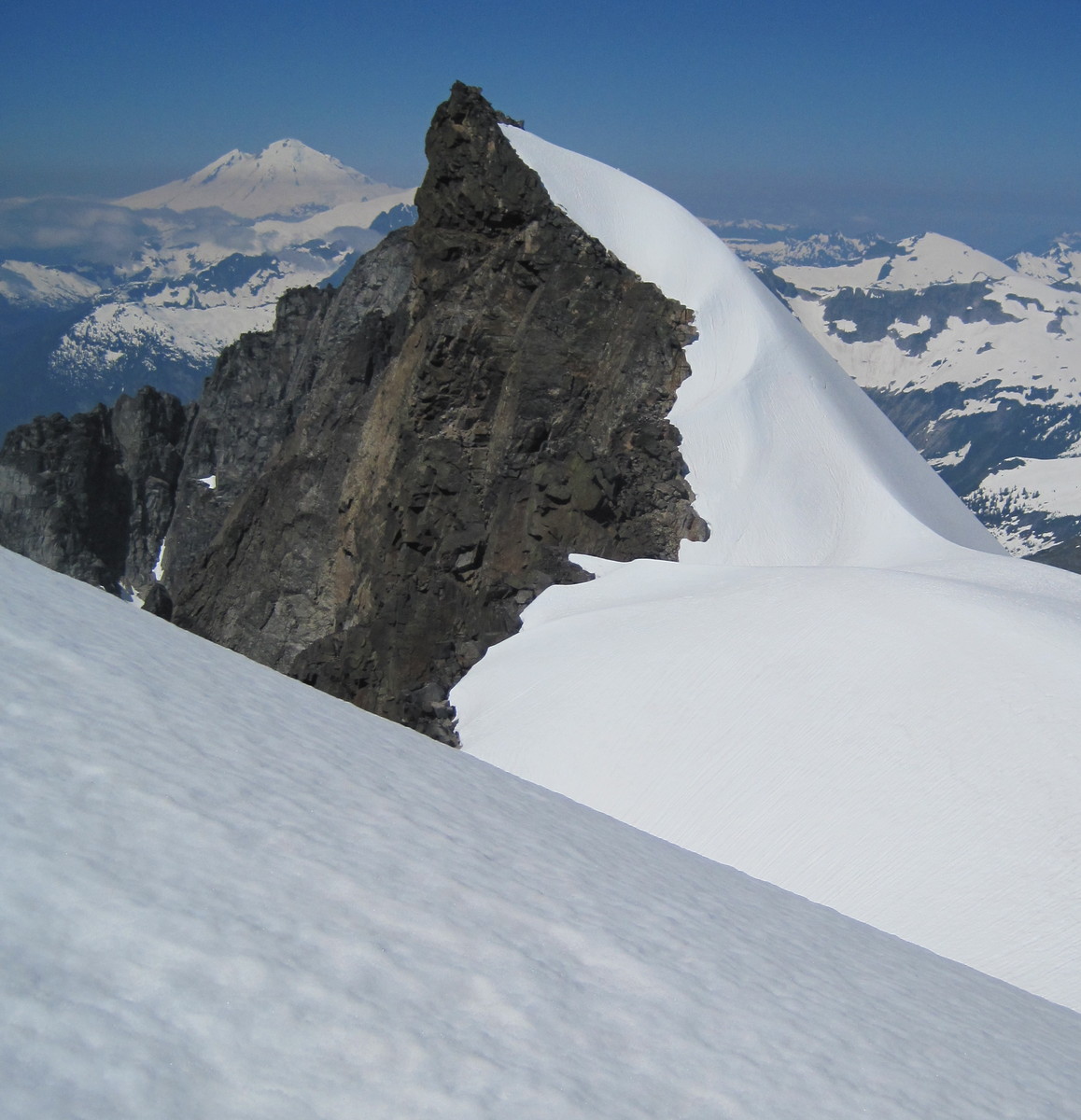
Fury
We met the other party coming down from the summit as we reached the rock. We all relaxed in the sunshine.
Then we started up the summit rock and they headed down.
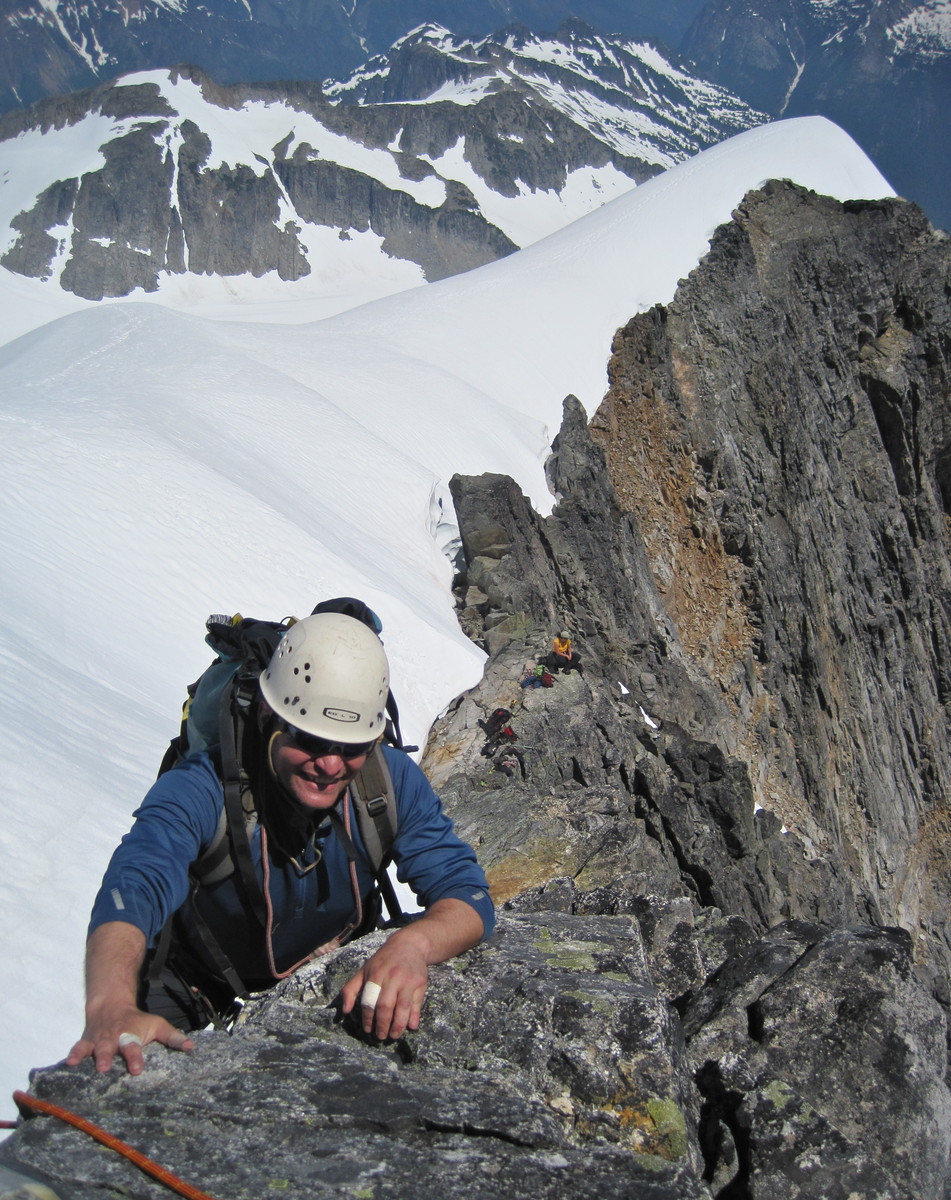
Ed decided not to do the last 5.7 step as he was feeling ill again.
He didn't seem to care about hitting the actual summit, so I continued alone.
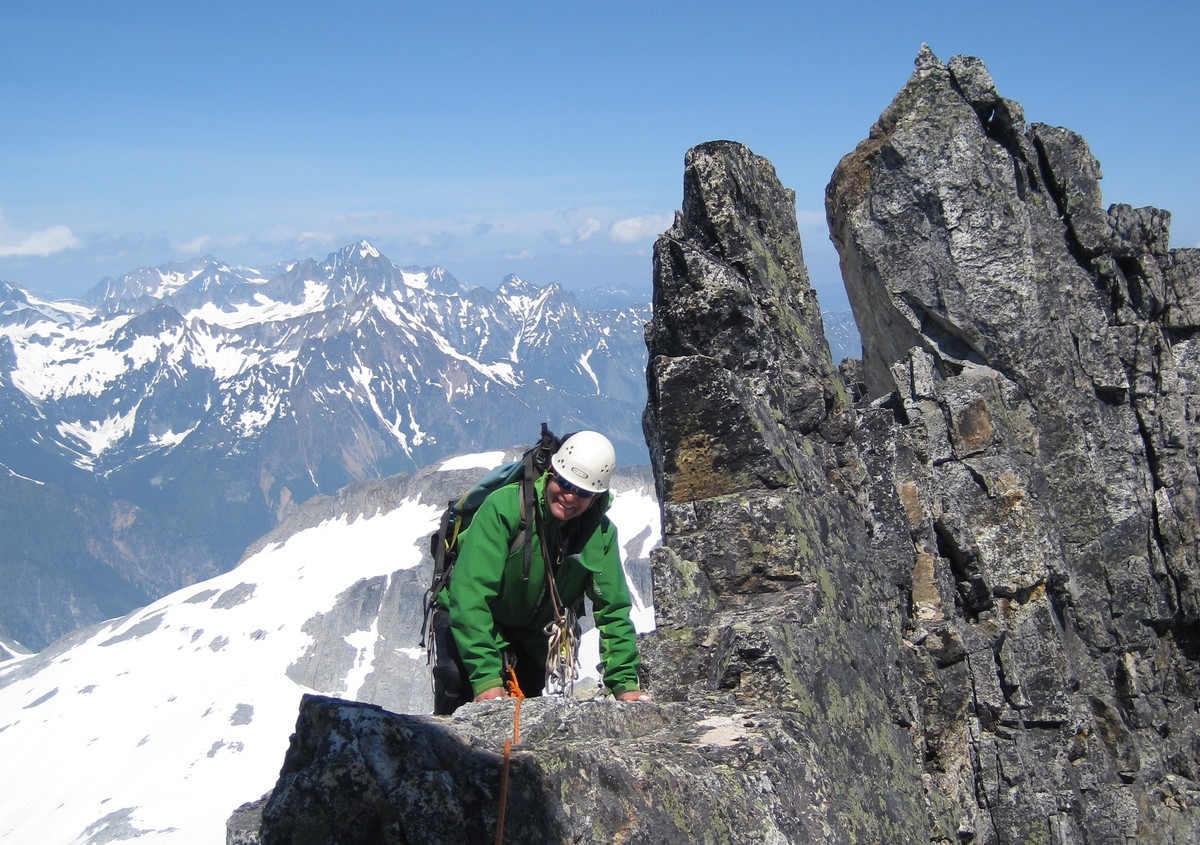
I took photos and some video on the summit on a windless, summer day. It was perfect.
Middle, West, Shuksan, Baker.
Luna.
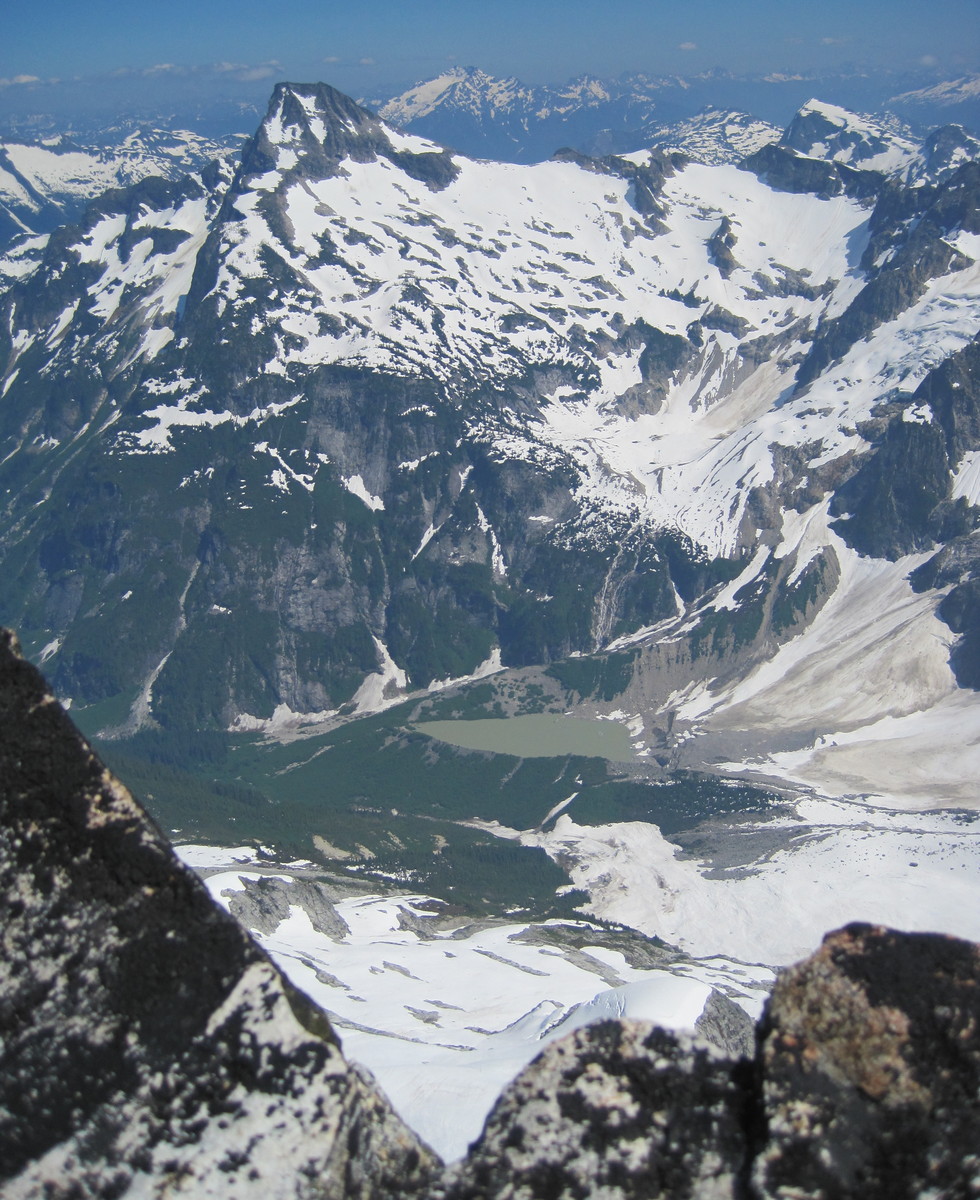
The spine of the northern Pickets.
Eventually, a thin wispy layer of clouds blew in at exactly the elevation of the summit.
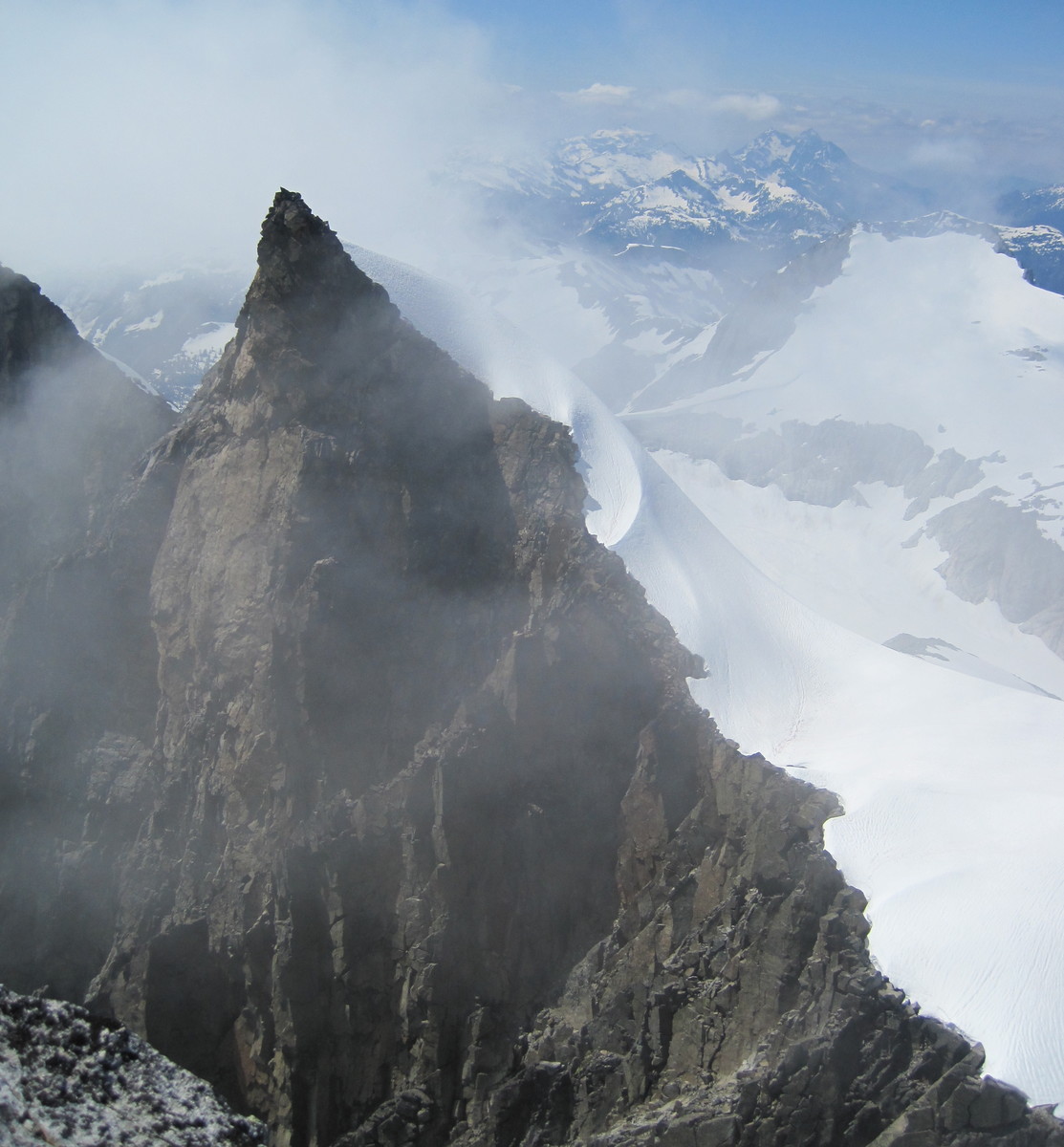
We re-traced our steps and rapped back to the snow.

Swirling thin clouds on the summits.
Back on the Challenger Arm

Fury.
Starting across the Challenger glacier again. Can you spot our tracks from the morning?
Back at Perfect Pass, we met Mario and a bushwhackers group who'd followed our footsteps along Easy Ridge.
They were skeptical about the weather, which was clouding up again.
Note to future travelers: Perfect Pass seems to make its own weather.
There were many times the following morning when the Challenger summit was out even though Perfect Pass was socked in.
Sunset at Perfect Pass: the end of a perfect day in the mountains.
DAY 5
The next morning we traversed under Whatcom Peak on an endless sidehill in the mist.
Challenger glacier.
Calving.
On Whatcom opposite the Challenger Glacier.
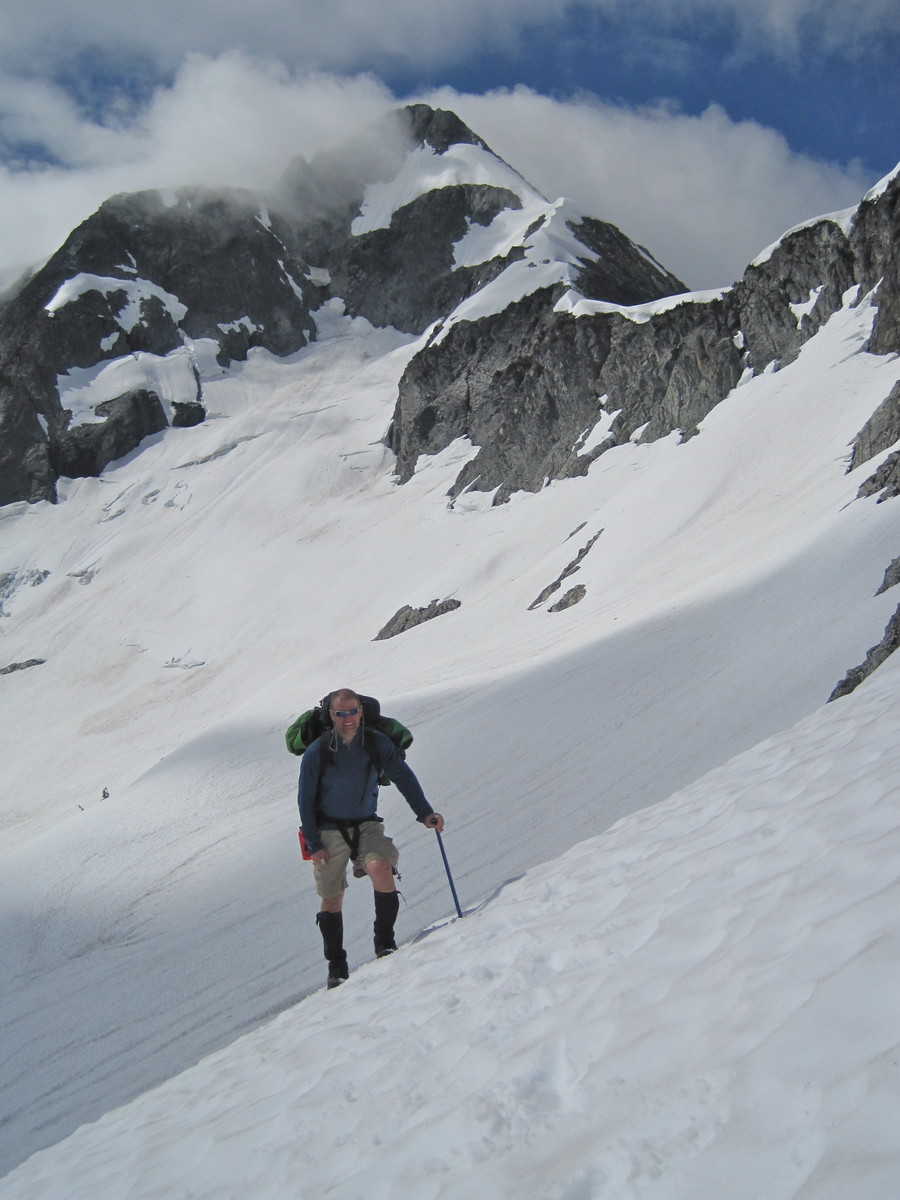
Things were pretty mellow, but you can't let your guard down in the Pickets.
Right after this photo...
Ed tripped and started accelerating down the slope head first on his back.
I watched in horror as he headed toward a small cliff band.
He dug in his ax, spun around, and came to a stop with his feet on a 4 inch ledge of rock sticking out of the snow at the top of a rock step. Yikes!
We continued.
We were getting close to Whatcom pass.
The end of our traverse was in sight.
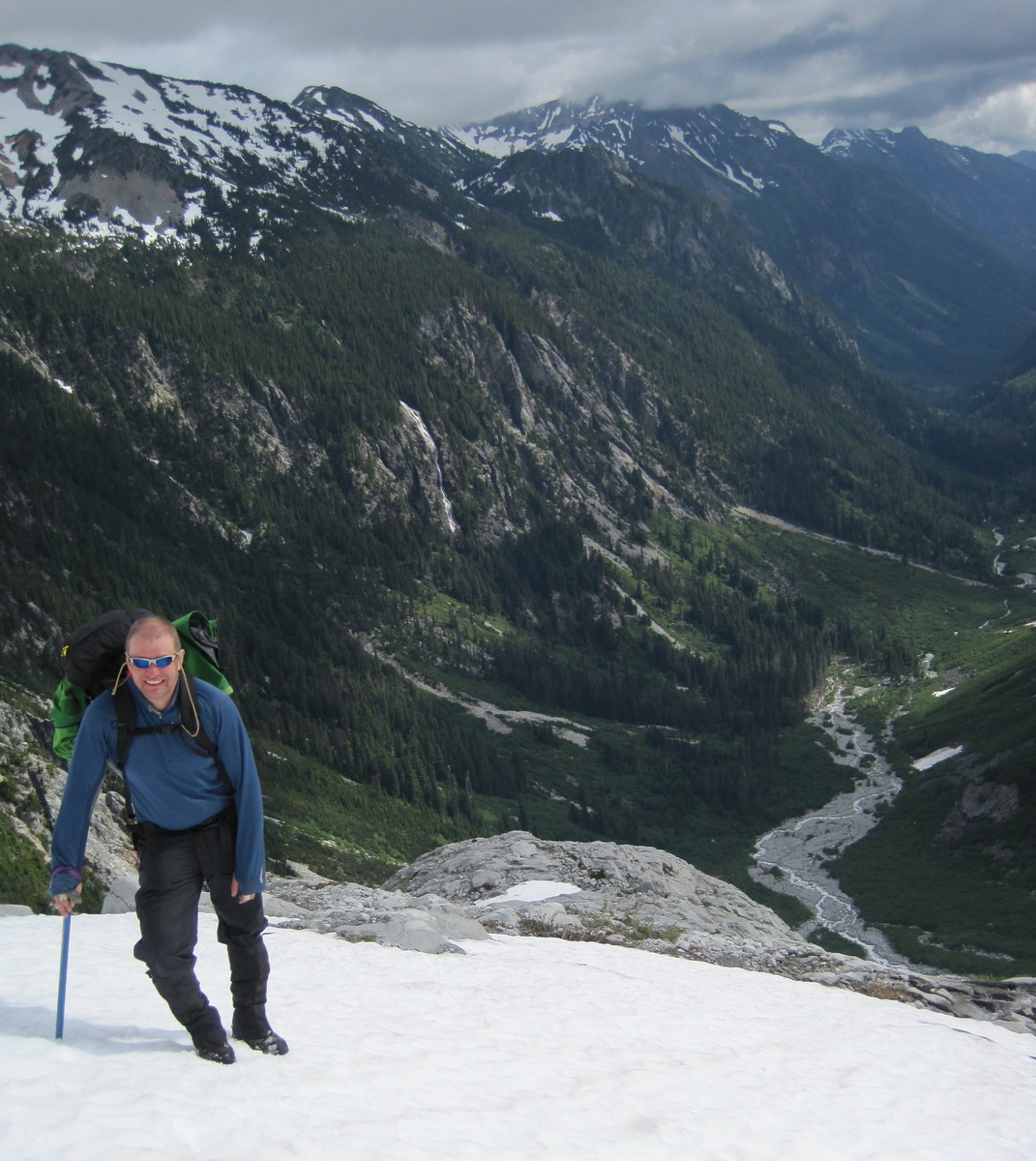
We crossed the last steep snow section and were 100 yards from level ground at Whatcom Pass when I got my turn.
I stepped over a hole in the snow, punched through up to my hip in a hidden tree well, and cartwheeled onto my back.
Just like Ed, I was heading down the hill headfirst on my back, this time toward some small trees.
I tried to arrest but my ax didn't grab right away. It seemed like slow motion.
I looked over and saw a small downed tree nearby, reached across my body, latched onto it, my body swung around, and I stopped.
A searing pain deep in my shoulder told me I'd damaged something.
At Whatcom Pass I popped some vitamin I and we kept going.
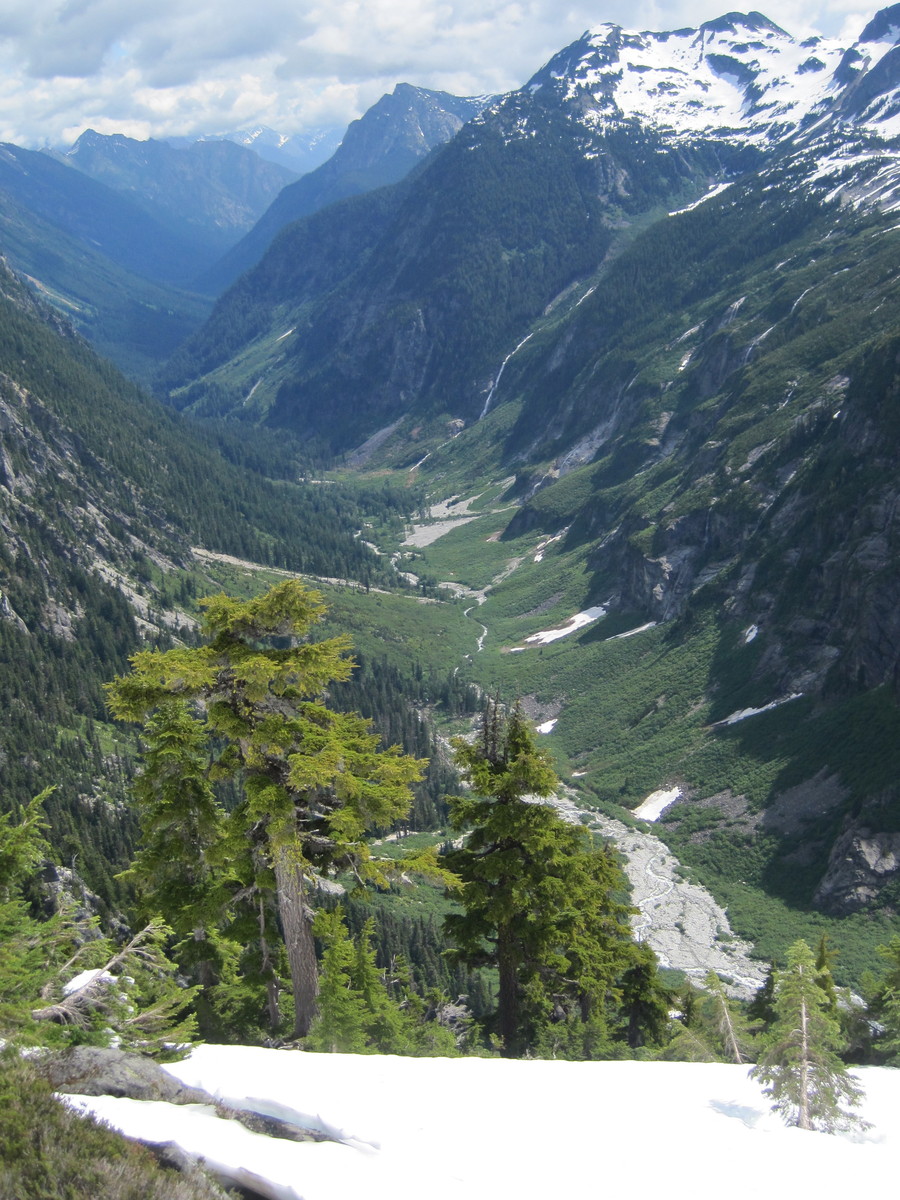
Whatcom

It took a while to find the route down from Whatcom Pass, but eventually we found the trail and dropped down into gorgeous forest.
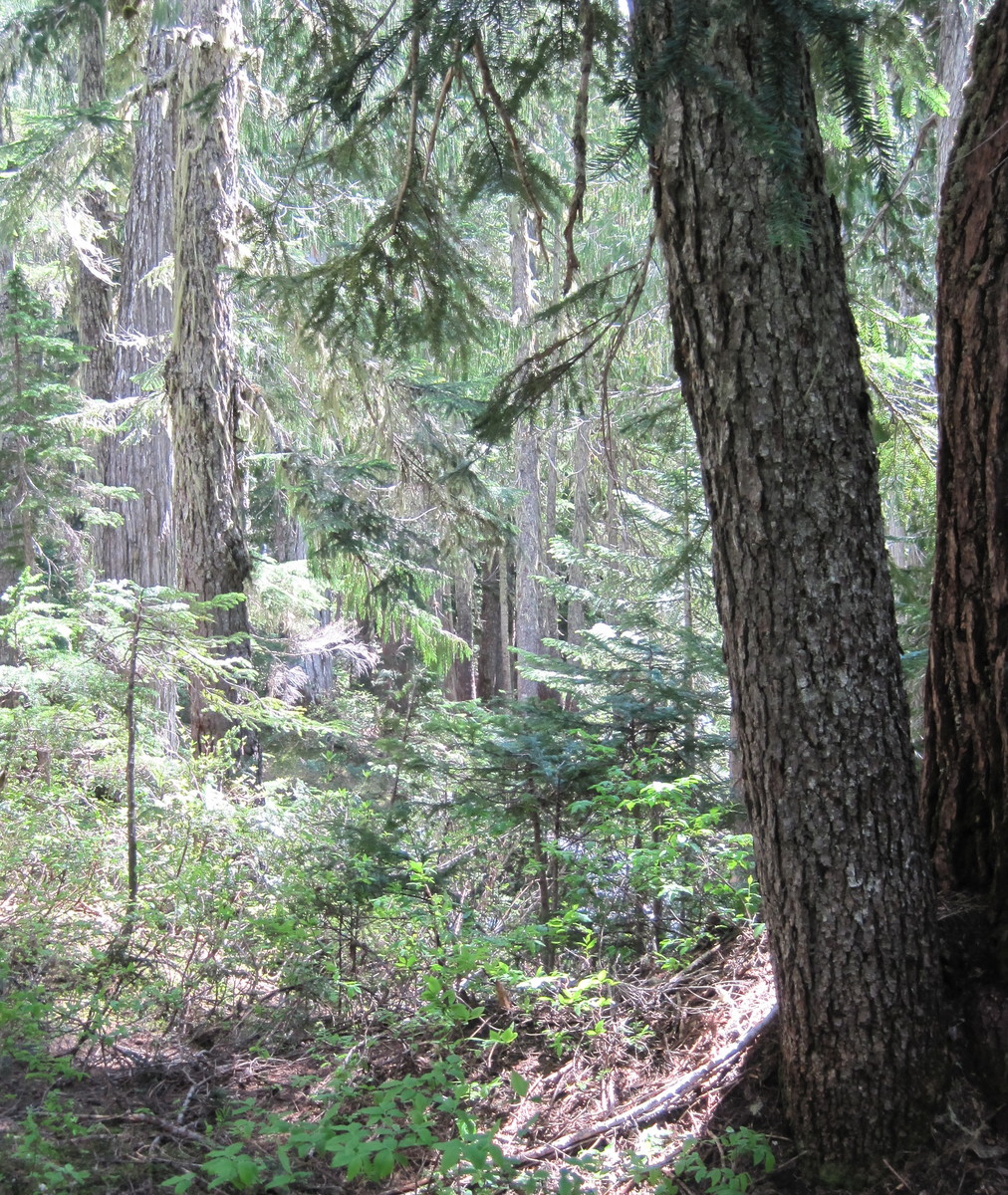
In many places, the greenery was so thick you couldn't see your feet on the trail below you.
You just shuffled along and hoped for the best.
This was a low density spot.
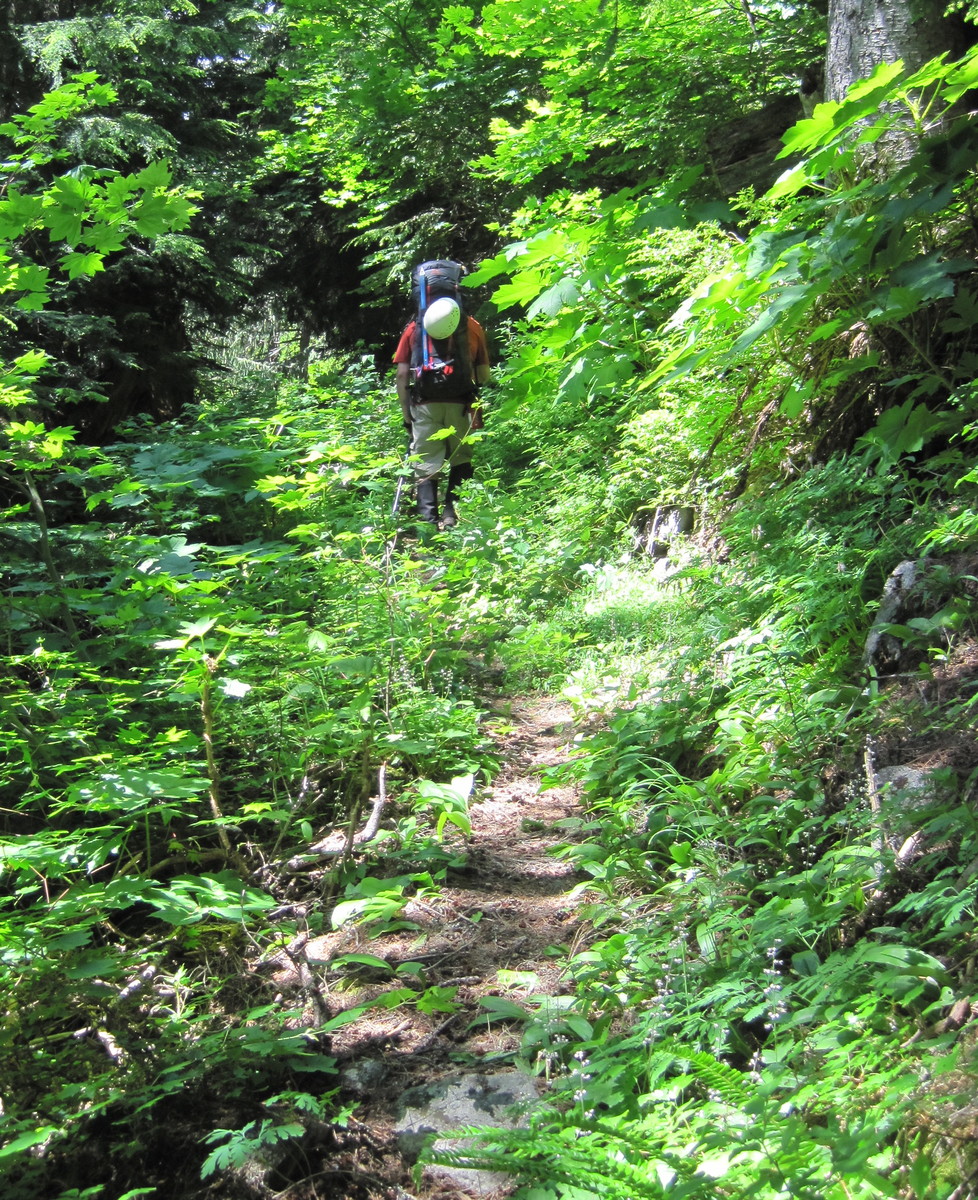
The sun was out,
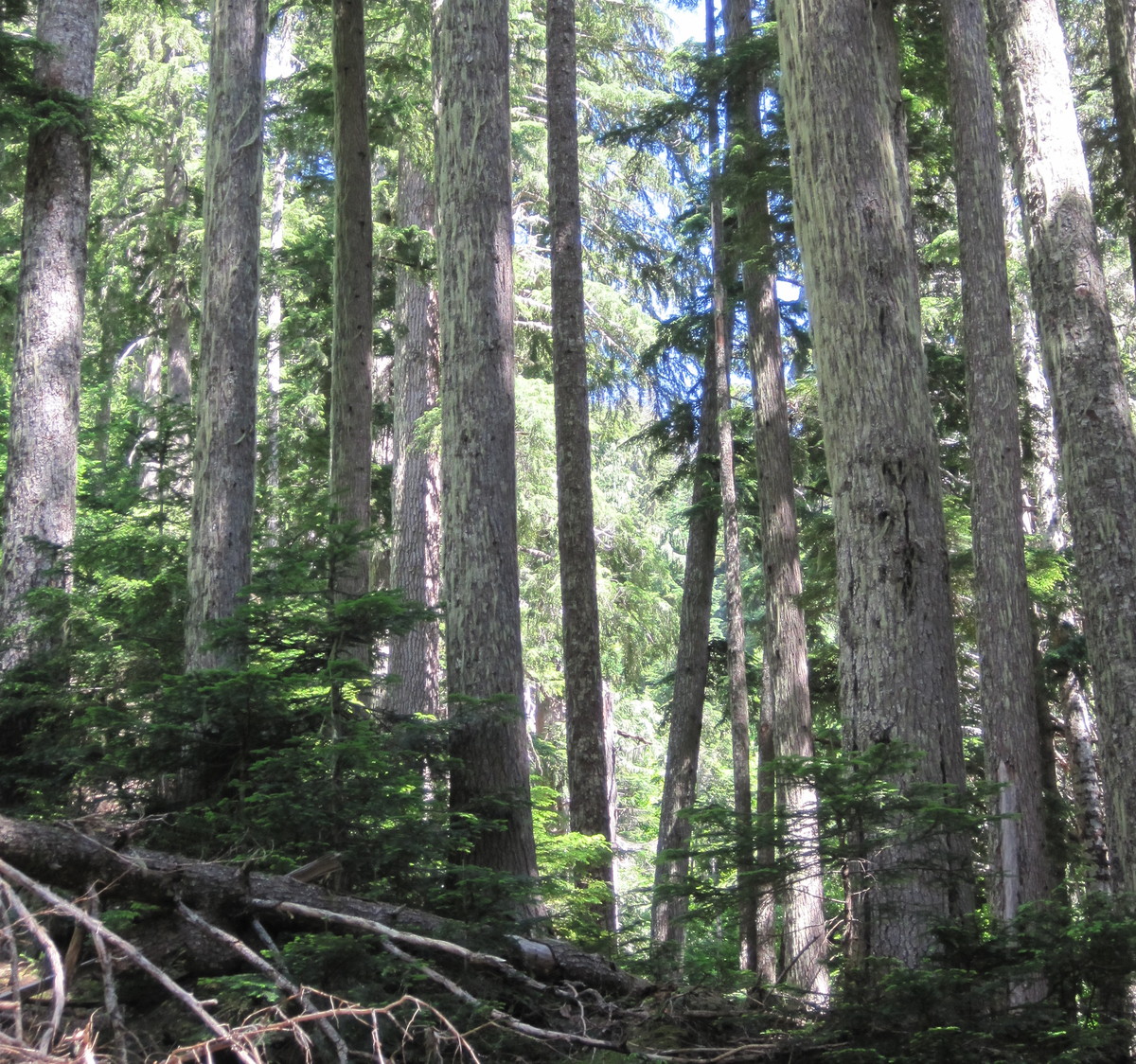
the bears were pooping,
and the views of Easy Ridge were great.
Looking up at the spot where we'd camped a few nights earlier, we noted how easy it would have been to have walked right off one of these cornices in the mist.
There were a few side creeks to cross, but nothing hard.
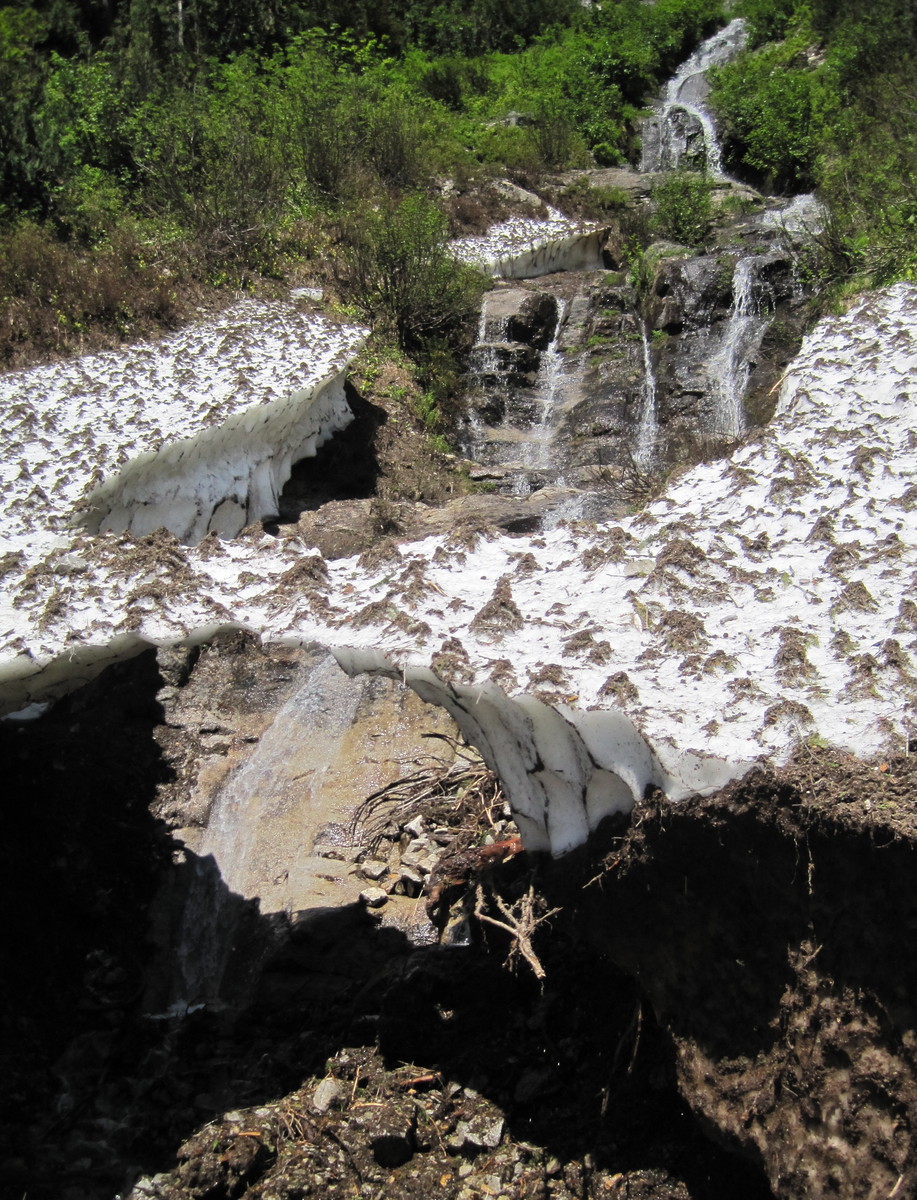
Tiger, tiger burning bright
In the forests of the night,
What immortal hand or eye
Could frame thy fearful symmetry? (Blake)

We took a dip and lounged in the sun at a perfect swimming spot.
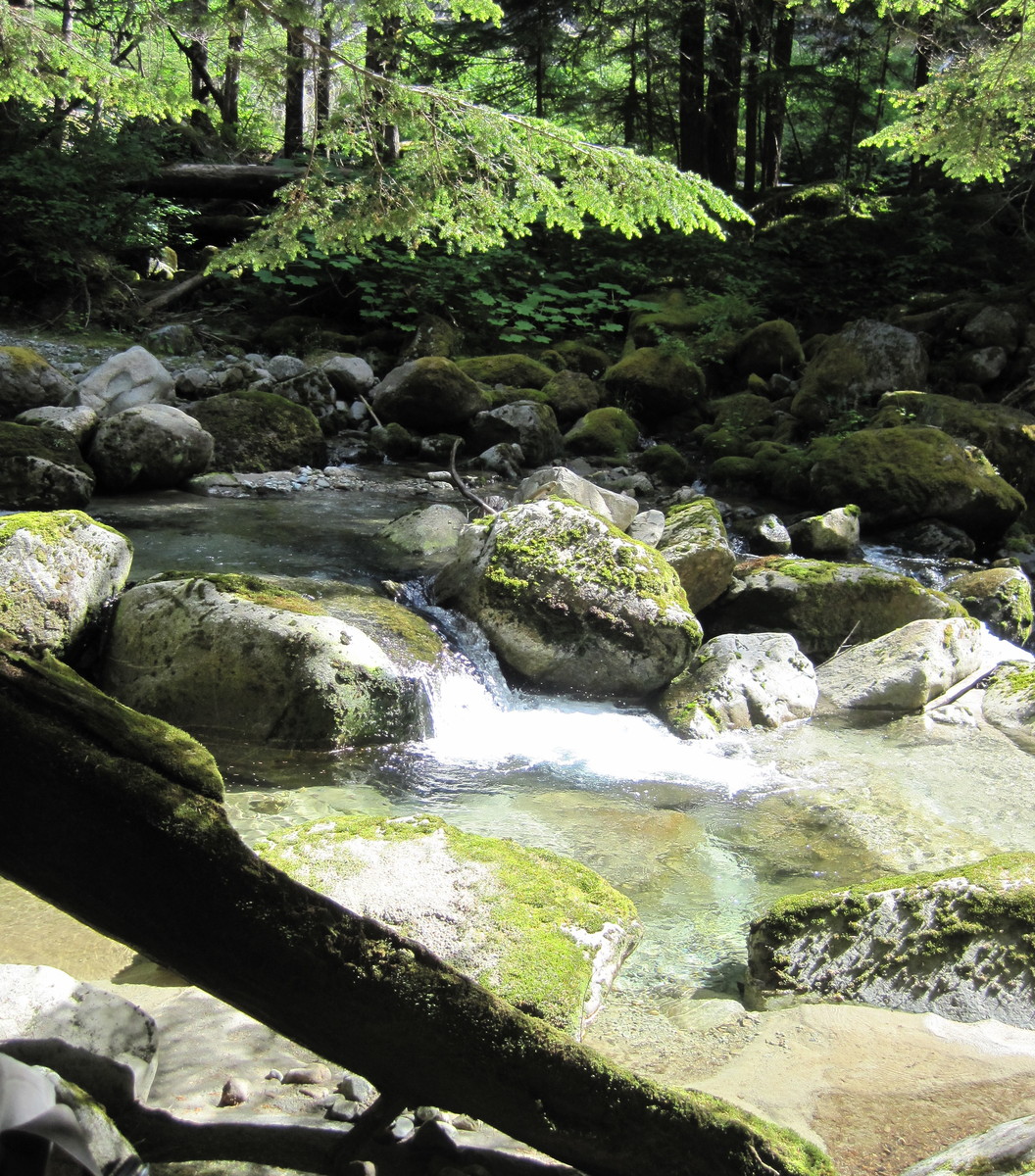
We encoutered a cryptic sign that read "Cable Car"
Really!!!???? Cool, let's check it out!
The vegetion on the trail was even denser than before.
Holy shit, batman!
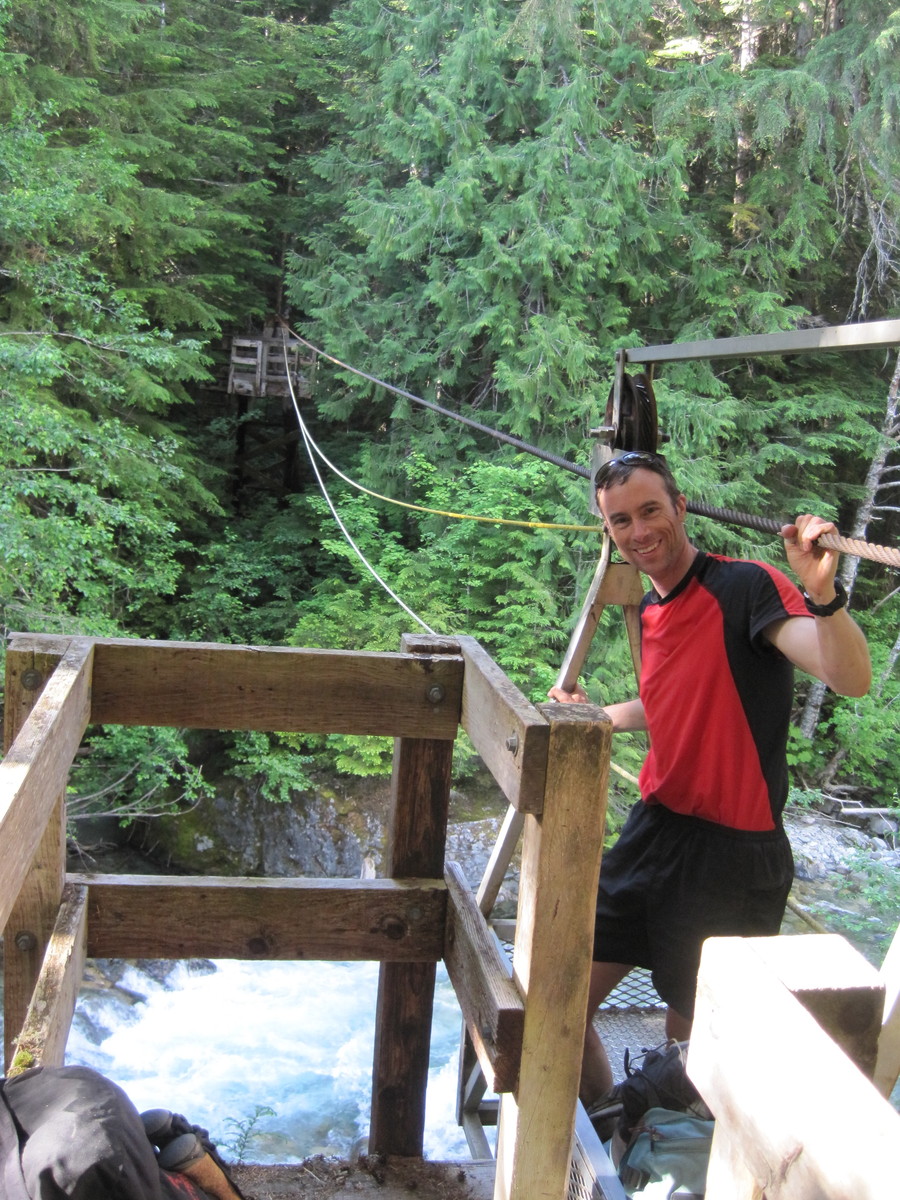
This thing was REALLY fun!

We didn't stop laughing for an hour.
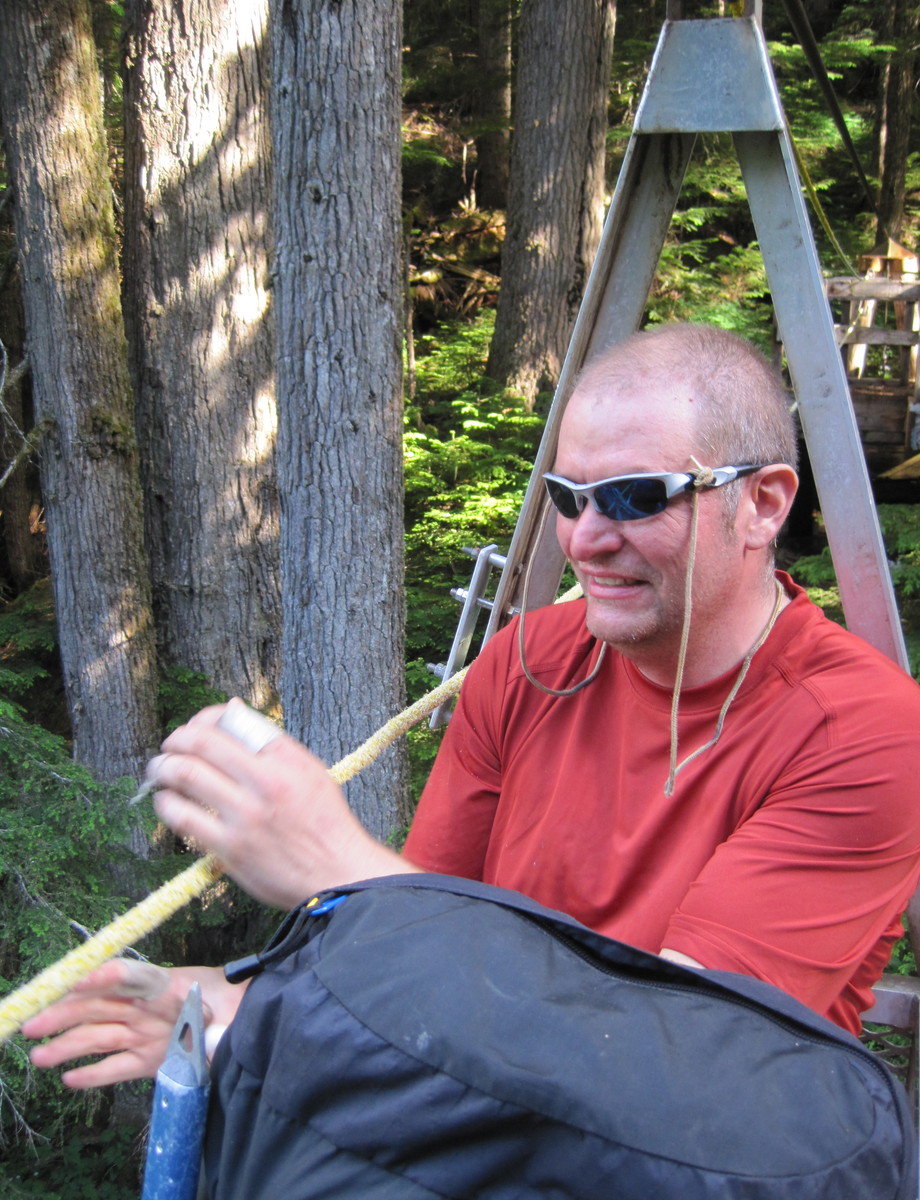
Engineer at work.
Where'd the trail go?
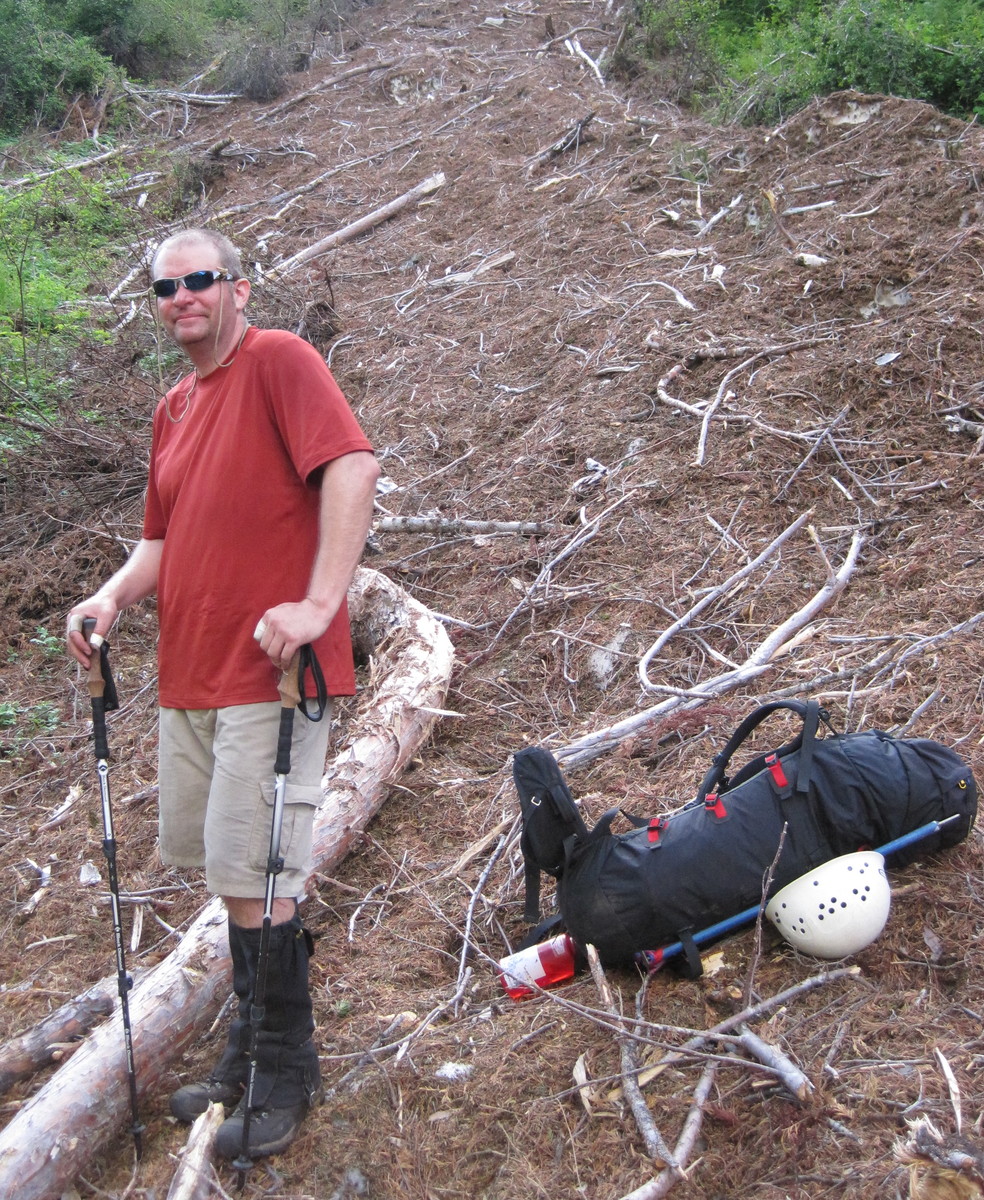
Avalanche devastation.
Trees snapped like matchsticks.
We continued up the trail for several more miles until we got to the turnoff for the Chiliwack crossing to Easy Ridge.
I had to get my cache of sneakers and food.
So...I went over
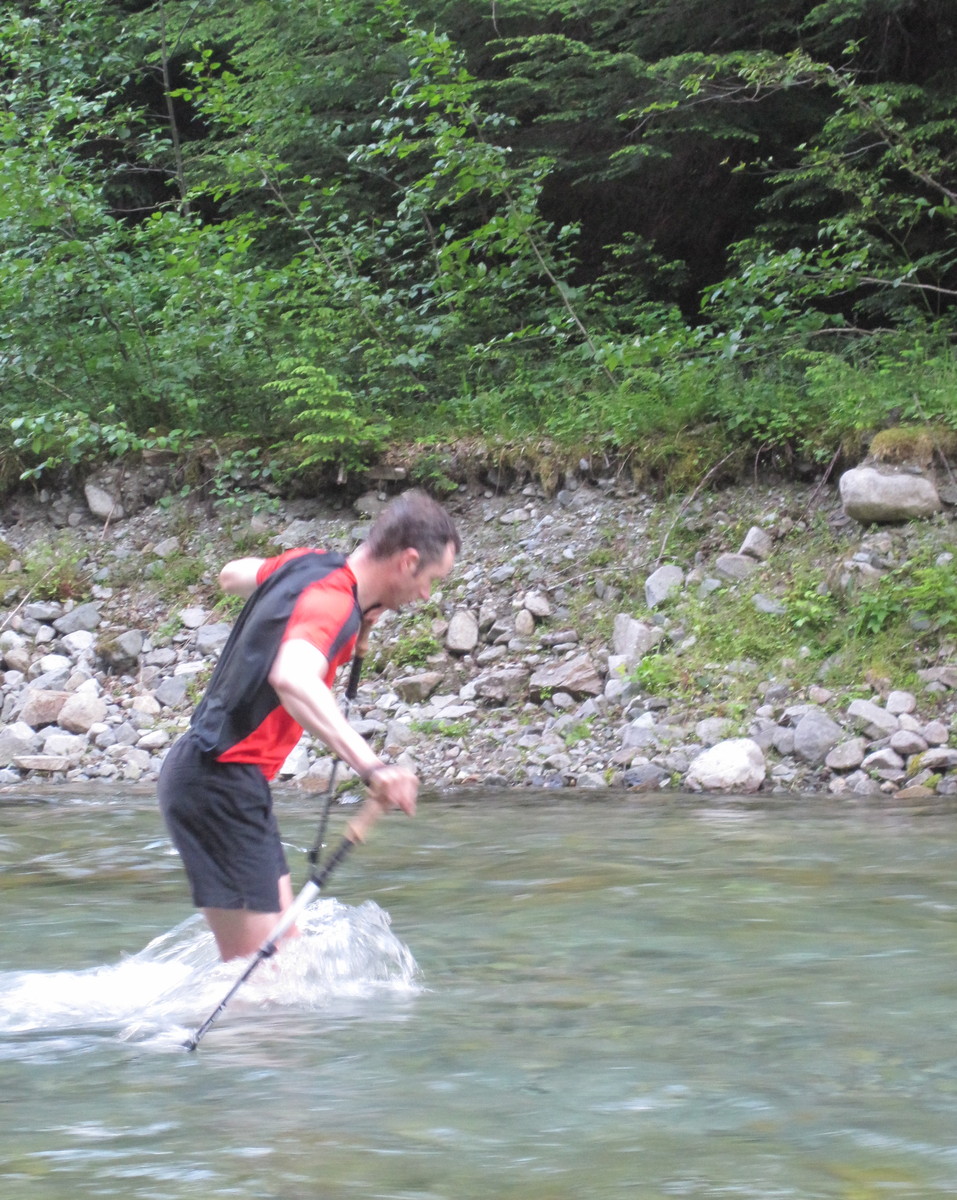
...and back.
And then on to our campsite up the trail. It had been a LONG day from Easy Pass to the campsite before the Chiliwack crossing.
DAY 6
The next morning we went over Hannegan Pass in brilliant sunshine.
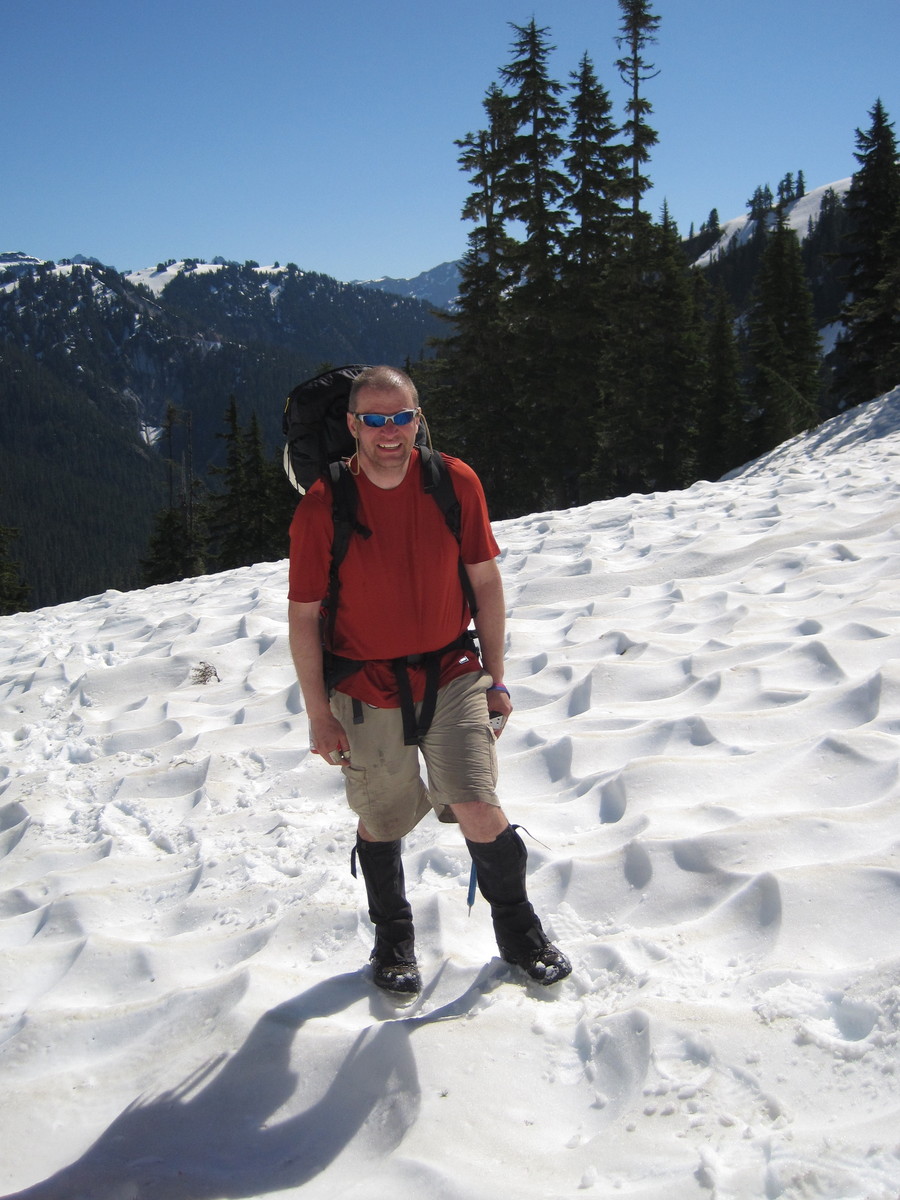
I had been worried about the creek crossing below Hannegan Pass.
It was less sketchy, but in the nice weather everyone and their poodle was trying it.
We scampered past and back to the trailhead.
Ran into dberdinka, who was out for a day on Ellation.
And then we went on to the Beer Shrine and home.
All in all, it was a challenging and rewarding experience in a gorgeous mountain wilderness.
Gear Notes:
Light rack for Challenger's summit, boots, ax, and a willingness to embrace uncertainty.
Approach Notes:
Hannegan trailhead. Other details are in the TR.
-
"Too light."
Nice one Rad. I think I agree.
Light is not necessarily right if you are going to be swinging your tool into some ice in the way that most of us visualize use of an ice axe. It just bounces off.
I was just looking for something to self-arrest if needed. If you plan to use it as a deadman in an anchor longer is stronger, I suppose.
-
If you got it from REI, use it, abuse it, and if you don't like it return it and get another. I picked one up in the yard sale for a small fraction of its retail cost. The problem on the tag: too light.

Really, if you want something to use like a trekking pole then get a trekking pole.
-
-
Good comments above.
Your concerns are reasonable, but pressing too hard is more likely to lead to tension in your relationship than increased safety. Maybe you can reassure him that he can still climb after a baby comes. #3 sounds like a good suggestion. He might consider posting on this site to try to find a partner - there should be plenty of interested parties. Scope them out by climbing S Face Adams. This serves a second purpose, which is to get the team more experience on snow at altitude in a safer (no crevasses) environment.
-
I manage on 5.7 - 5.8 hand cracks. I tear my hands up pretty well depending on the rock quality. In my circle of climbing acquaintances, there is a gent who's been climbing forever, used to solo in the .12s...really skilled and down-to-earth guy. His hands don't show any signs of crack-wear, and he doesn't tape up. He claims that with good technique you won't normally rip your skin up.
Is this something we have to deal with while learning crack technique, the whole tape thing...until we are good enough to not need it? I'm sure this has been beaten to death.
As with much of life, the truth lies in the middle. People learning to climb cracks often rattle their hands around, slide them up and down, and don't set them properly. This leads to scrapes and bleeding. With practice, you'll get better at setting hand/finger jams right the first time and greatly reduce abrasion in the process. So there is some truth to what you say.
However, even experts (witness the UKC video) tape under certain circumstances and for particularly abrasive rock because it can save your skin and reduce the pain factor. Different strokes for different folks: Dean Potter tapes. Alex Honnold (as far as I've seen) doesn't.
-
-
That link is no good!
fixed now
-
These are fairly objective, though ability comes into play as well. Snakedike is a good example. The route is 5.7, the 5.7 cruxes are well protected, and the super runout terrain is on 5.2 or 5.easy ground where a solid 5.7 leader is very unlikely to fall.
I am with you but I am not sure the above is entirely consistent ("ability comes in to play"). Although I don't remember the climb very well, Snake dike is R rated.
You're right, Snakedike does have an R rating.
-
I suspect there are two separate issues here: R and X ratings and the perception of whether a route is runout.
From a ratings standpoint, R (runout) usually means there is a high probability of some type of injury if you fall at the wrong spot. X is similar but there's a decent chance you'll die or be crippled if you screw up.
A long clean fall may not be grounds for an R rating (e.g. Tuolumne slabs or an overhanging sport route). It depends on the consequences of the fall. Short falls can be dangerous too, such as a pendulum onto a sharp flake or a hard move with groundfall potential or a spot where the rope is likely to come taut over a sharp edge.
These are fairly objective, though ability comes into play as well. Snakedike is a good example. The route is 5.7, the 5.7 cruxes are well protected, and the super runout terrain is on 5.2 or 5.easy ground where a solid 5.7 leader is very unlikely to fall.
These all assume you know how to place solid protection and fall safely (slide without tumbling on a slab, that you won't flip due to having the rope behind your leg etc.).
What most people above are talking about is the PERCEPTION of whether something is runout or not. That is highly subjective and can change from one person to the next and one day to the next with the same climber, as noted above.
-
Good news indeed!
-
Yep. Good work and a reasonable turnaround.
-
Thanks Gene. I am thankful.
Sometimes I think we should have a day or moment of silence to remember, and perhaps even ask forgiveness from, all the souls we snuffed out in the name of (fill in your favorite cause).
Today, I found myself explaining to my 8yo son that native americans who want to govern themselves live in small reservations because we killed most of their ancestors with disease and weapons and took away the land they watched over for thousands of years. Sorry doesn't seem strong enough.
-
Can't help but read this and think if that had been a climber EVERY comment would say "charge those reckless idiots!"
-
Bunch of new 11s at X38 Far Side. 4 11s and a 12 at Shangri La, 2 11s on the way to same, 1 11 at Gunshow on the far right. And a few harder things in the works.



Falcon Closures-Chief : GRAND WALL
in British Columbia/Canada
Posted
Thanks!